

How to Make a Fishing Rod Travel Case: A DIY Guide for Anglers
Linda Johnson
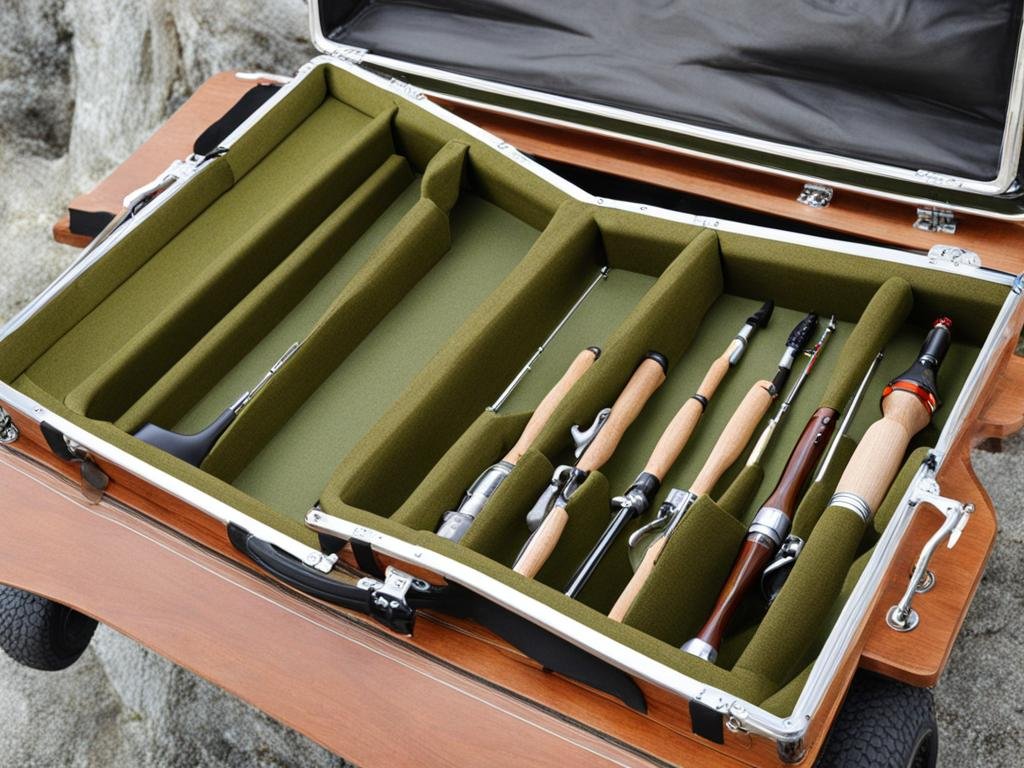
Affiliate Disclaimer
As an affiliate, we may earn a commission from qualifying purchases. We get commissions for purchases made through links on this website from Amazon and other third parties.
If you’re an angler who loves to explore new fishing spots, you know the importance of protecting your gear during travel. A fishing rod travel case is essential for keeping your rods safe from damage while on the move.
In this article, we’ll guide you through the steps to create your fishing rod travel case, ensuring that your equipment remains secure no matter where your adventures take you.
Understanding the Need for a Fishing Rod Travel Case

Before diving into the making process, let’s understand why a fishing rod travel case is a wise investment. Transporting fishing rods without proper protection can lead to scratches, dents, or breaks. A travel case minimises these risks and makes carrying multiple rods more convenient. It’s about giving you peace of mind while focusing on catching the big one.
Materials and Tools Required
To get started, gather the following materials:
- PVC pipe (2-3 inches in diameter, length depending on your rod)
- PVC pipe end caps
- Foam padding
- Adhesive (suitable for foam and plastic)
- A saw (for cutting PVC)
- Strap or handle for carrying
- Drill and screws (for attaching the strap or handle)
Step-by-Step Guide to Making a Fishing Rod Travel Case
Step 1: measuring and cutting the pvc pipe.
Measure the length of your longest fishing rod and add a few extra inches to ensure enough space for padding at both ends. Use the saw to cut the PVC pipe to the desired length. Smooth the cut edges with sandpaper to prevent sharp edges from damaging your rods.
Step 2: Padding the Interior
Cut the foam padding to fit the interior circumference of the PVC pipe. The padding should be thick enough to cushion the rods but not so bulky that it becomes difficult to insert them. Use adhesive to secure the padding in place, ensuring it’s evenly distributed along the length of the pipe.
Step 3: Preparing the End Caps
Drill holes into the centre of each end cap. These will allow you to secure the caps to the PVC pipe after placing your rods inside. Optionally, line the inner side of the end caps with foam padding for added protection.
Step 4: Attaching the Strap or Handle
Decide whether you prefer a shoulder strap or a simple handle for carrying your case. For a shoulder strap, attach D-rings to the side of the PVC pipe using screws, and clip the strap onto the rings. For a handle, use a sturdy material like nylon webbing, and attach it with screws to create a comfortable grip.
Step 5: Assembling the Case
Once the adhesive has dried and all components are prepared, it’s time to assemble your travel case. Place your fishing rods inside the padded PVC pipe, and secure the end caps with screws. This method allows you to open the case easily while keeping everything tightly secured during transit.
Additional Tips for a Customized Case
- Consider painting the exterior of your PVC pipe for a personal touch or to add visibility.
- For extra security, install a screw-on cleanout plug instead of a standard end cap on one end of the pipe.
- Label your case with your name and contact information if it gets misplaced during your travels.
Which Type of Fishing Rod is Best Suited for a Travel Case?
When choosing a fishing rod for travel, consider the advantages of onepiece vs. twopiece fishing rods . While onepiece rods offer seamless action and sensitivity, twopiece rods are more convenient for packing and transportation. Choose based on your fishing style and travel needs.
Maintaining Your Fishing Rod Travel Case
Regularly check your case for any signs of wear and tear. Keep the screws tight, and if the foam padding begins to degrade, replace it to maintain optimal protection.
Creating a fishing rod travel case is a practical project that enhances your fishing experience by ensuring the safety of your rods during travel. You can craft a durable and customized case with simple tools and materials. This homemade solution saves money and provides a sense of accomplishment as you take the gear you’ve protected with your hands to the waters.
Where to Find Materials
You can find the necessary materials at your local hardware store or through online retailers. For example, Amazon offers a variety of PVC pipes and related accessories.

Remember, the goal is to get to your favourite fishing spot with all your equipment in top condition, ready for the challenge. You’re all set for a successful and stress-free fishing trip with your new travel case. Happy angling!
About the author
Linda Johnson is a marine biologist with over 15 years of experience. She has spent a large portion of her career studying fish behaviour and habitats.
Latest posts
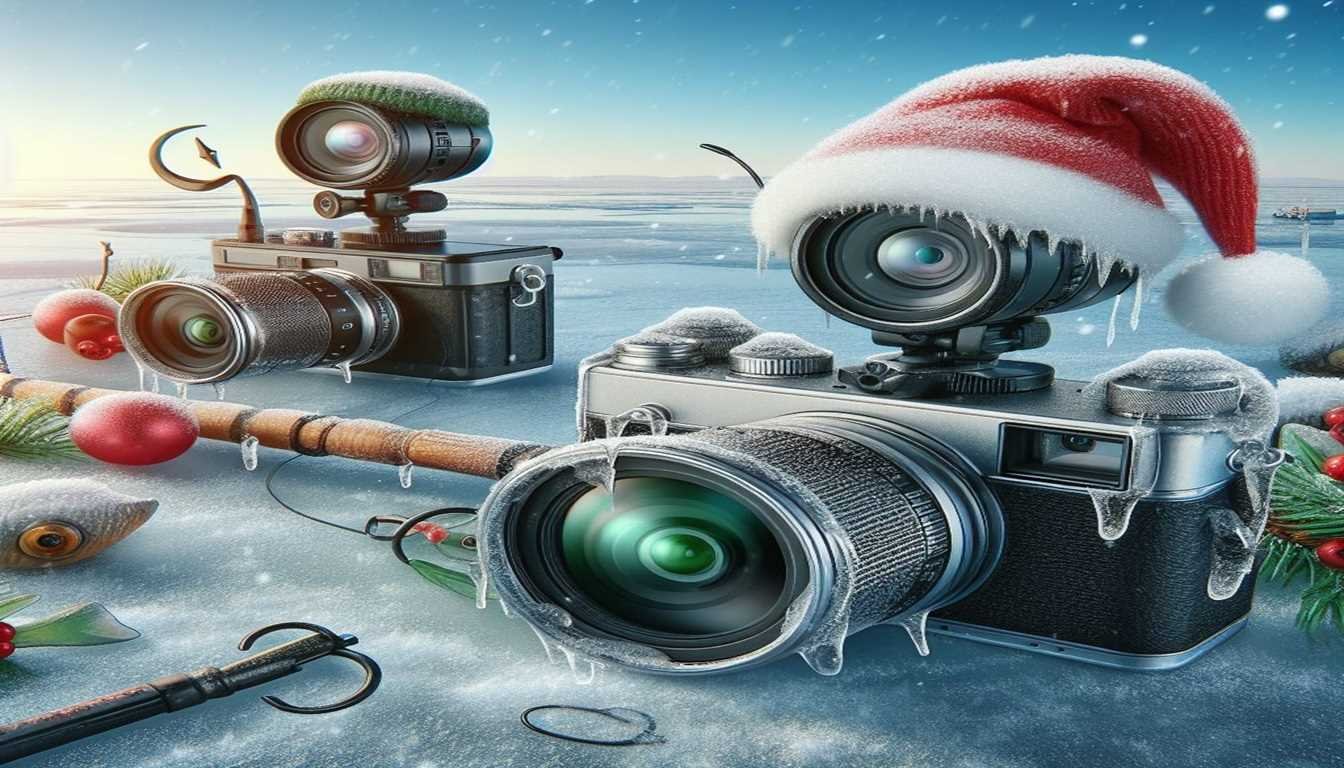
8 Best Ice Fishing Cameras for Your Next Winter Adventure!
“Dive under the ice with our top 8 ice fishing cameras! Perfect your winter fishing adventures with tech…
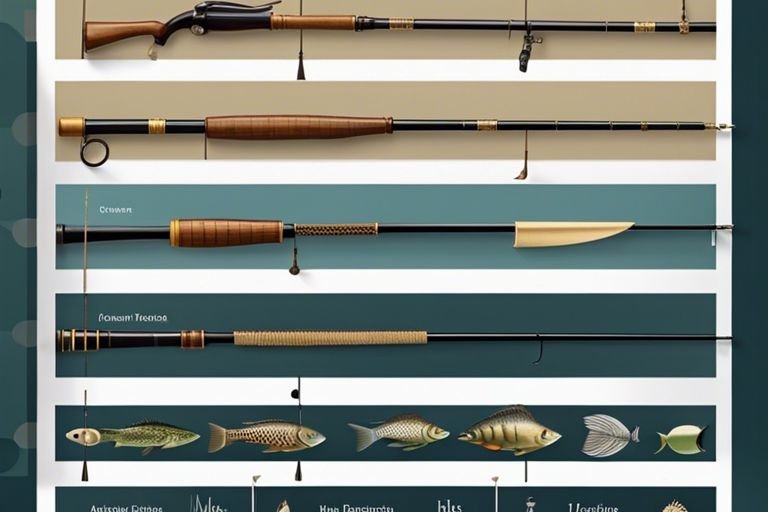
When Were Fishing Rods Invented? A Journey Through Fishing History
Dive into the history of fishing rods, from their 2000 BC origins to today’s high-tech gear. Explore the…
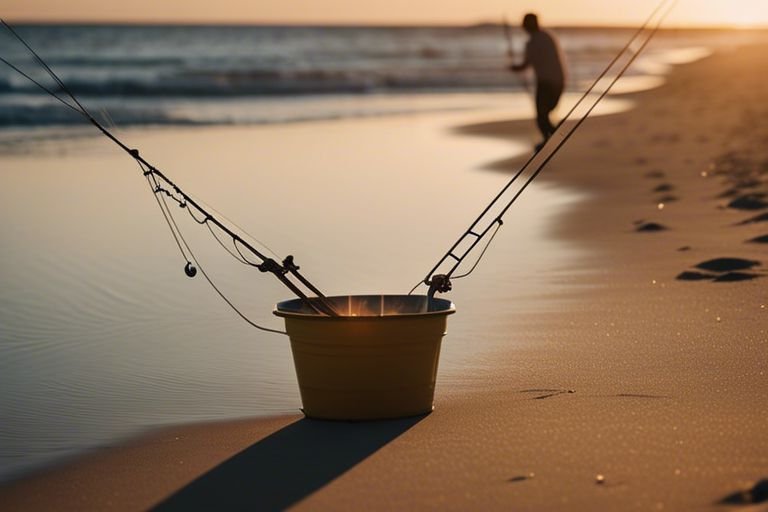
How to Find Sand Fleas: Unleash the Power of Fresh Bait
Learn how to find sand fleas for saltwater fishing and unleash the power of fresh bait for catching…

Reckon I’ll
Fish • Hunt • Paddle
DIY: Building A Fishing Rod Carrier That Can Trek Cross-Country

My father typically rents a van to make our somewhat frequent trips to the coast during the summer as it better accommodates the mounds of gear we bring when we vacation. This makes it easy to pack in the surf rods without too much hassle.
Unfortunately, with the rental companies selling their fleets during COVID-19, rentals are few and far between, and if you can find one, you will have to pay dearly for it.
I decided to jump in and build a rod carrier that could handle the trek to Alabama on the roof rack of their Subaru.
How To Build It
Building the rod tube, materials needed.
- 4″ PVC Pipe
- 4″ PVC Slip End Cap
- 4″ Threaded Fitting
- 4″ Threaded End Cap
- Protective Foam
- Grouting Sponge (2)
Step 1: Cut the Tube to Length
Using your maximum length rod as a point of reference, cut the tube 3” longer than your longest rod.
In my case the longest rod is 7’6” so I cut the tube to 7’8”.

Begin by laying out the 1” square tube as seen in the picture above and welding the frame together. The heavier 11ga square tube will help to anchor the frame.
Step 2: Cut Padding for the Caps
Using the cap as a template, cut two circles of grouting sponge to serve as padding for the end caps.

Step 3: Glue on the Slip Cap
Place one of the circles of sponge inside the side you plan to cap.

Glue the slip cap onto one end of the pipe.

Step 4: Glue the Threaded Cap Receiver
Glue the threaded cap receiver onto the other end of the pipe.

Building the Adjustable Brackets
The brackets are made from aluminum angle connected to a length of flat stock. The brackets are designed to be adjustable to fit any size luggage rack bar. I chose to route mine to allow that adjustability.
Tip: Screw It Tight You want everything here snug! I use some door wax to coax the dowel through the same-size hole but you can drill out slightly with a hand drill. You can also use needle nose to open up the alligator clip attachment point a bit.
- 4″ Plumber’s U-bolts
- 1″ (1/4″ thick) Aluminum Flat Bar
- 1.5″ x 1.5″ (1/8″ wall) Aluminum Angle
Step 1: Cut Angle for Adjustable Bracket Ends
Cut four 6″ lengths of aluminum angle. Two pieces are used per bracket, and you will need two brackets to hold the rod tube.

Step 2: Align and Scribe the Top of the Brackets
Its important to ensure that the brackets hardware will lineup with each other. Using two machine vises, I lineup all four brackets and score a straight line across the top using a square.

Step 3: Scribe the Bottom of the Bracket
Using the U-bolt as a template (the spread will vary on each U-bolt so just pick one), align the top line with the center of one threaded end of the U-bolt.
Mark and scribe a line at the bottom of the bracket where the center of the other threaded end of the U-bolt will land.

Step 4: Mark the Drill Location for the U-bolts
Find the center of the bracket where you want to drill the hole for the u-bolt. Be sure to account for the extra 1/8″ angle on the bottom-side.
Scribe a line down the center. Using a punch, mark the interaction of the lines at both the top and bottom of the bracket. This will be where you drill.

Step 5: Drill the U-Bolt Holes for All Four Brackets
Align your drill bit with the intersection you marked at the top and bottom of each bracket and drill a 3/8″ hole. Take your time as precision is key here.
Tip: Work Your Way Up Don’t immediately start with the 3/8″ drill bit. Use a small bit to make the first hole and incrementally work your way up. The drilling will be easier and more precise.

Check the bracket is aligned properly by test fitting after you finish each side.

Step 6: Mark the Center of One Side of the Bracket
The bracket will have one fixed-side and one adjustable side. You need to drill a hole to accommodate the adjustable side.
Measure the distance between to the two holes and mark the center with a punch.
Tip: Find the Center Quick I love using digital calipers with aluminum. You can quickly find the distance between the two holes, divide it by two and using the digital calipers, scribe the center.

Step 7: Drill The Center Hole on the Adjustable-side of the Bracket
Drill a 5/16″ hole at the marked center of one-side of the bracket. Again, work your way up from a smaller bit to the 5/16″ bit.

Step 8: Cut Lengths to Form the Adjustable Channel
Cut four 9″ lengths of the 1″x 1/4″ stock. This will be used to form the channel the links the two brackets.

Step 9: Attach the Fixed End of Each Bracket
The 9″ length of stock will be welded to side of the bracket without the middle screw. Be sure to clamp it where a 5/16″ screw can easily slide into the center hole.

Weld the first piece in place.

Step 10: Weld the Remaining Channel
On the other side of the hole, being sure the pieces are parallel and a screw can easily fit the entire length of the channel, weld the second piece in place.

Weld all sides of each piece of 1″ stock and the fixed-side of the bracket.

Step 11: Cut the End Piece of the Channel
In order to firm up the channel, cut an end piece of scrap stock the width of the channel pieces. You can use a small length of the 1″ stock if you do not have scrap.
I chose to use a smaller piece of scrap stock.

Step 12: Attach the End of the Channel
Weld the piece cut in step 11 to the end of the channel.

Step 13: Assemble the Bracket
Place a small washer on top of the angle iron and thread the 5/16″ x 1″ bolt through the bracket and the channel.

Place a larger fender washer on the back and hand-tighten a nyloc nut.

Step 14: Attach the U-Bolts
Thread the U-Bolts into each bracket and hand tighten the provided nuts with the U-bolts onto each end. Your bracket is complete.

Final Product
Upon completion, you should have a rock-solid carrier that can adjust to any car rack you throw its way.

Leave a Reply Cancel reply
You must be logged in to post a comment.
- Tips and Tricks
- Tips from Elsewhere
- Entries feed
- Comments feed
- WordPress.org
Legal and Other
- Privacy Policy
- Liability Disclaimer
- Affiliate Disclosure
Recent Posts
- DIY: Tie A Climbing Stick Daisy Chain for Mobile Hunting Out of a Treestand or Saddle
- DIY: Storing An Aider on a Big B.O.B., EWO Ultimate One Stick, or Any Other One Stick
- DIY: Convert Low-Quality Habitat Into A Food Plot
- DIY: Tie A Full Bury Amsteel Climbing Stick Rope
- DIY: Turn A 50 Gallon Barrel Into A Mobile Water System for Food Plotting
Upcoming Posts
- September 2023
- August 2023
- February 2023
- January 2023
- October 2022
- September 2022
- August 2022
- February 2022
- January 2022
- December 2021
- November 2021
- October 2021
- September 2021
- August 2021
- February 2021
- January 2021
- December 2020
- November 2020
- September 2020
- October 2014
- September 2014
- February 2013
- September 2012
- September 2011
Liability Disclaimer | Privacy Policy | Affliate Disclosure | © 2021 Reckon I'll
Affiliate Disclosure - Privacy Policy
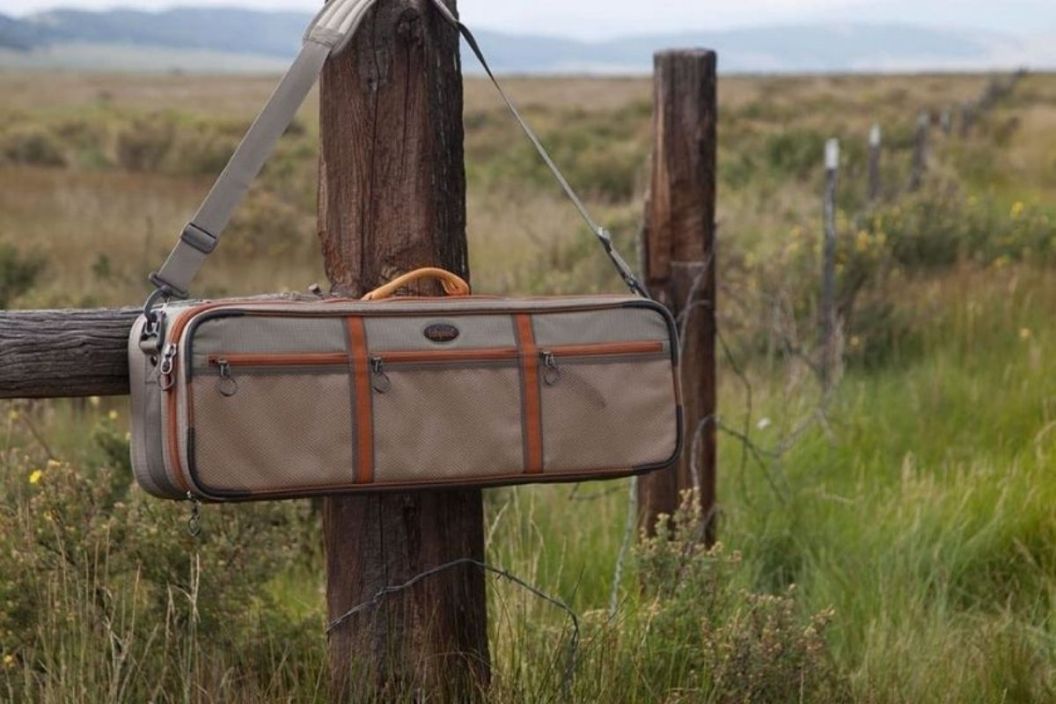
6 Best Fishing Rod Travel Cases for Airline Travel & More
The easiest way to carry multiple fishing rods is with a fishing rod travel case..
Whether you need to pack five spinning rods and fly fishing rods for a weekend full of fishing , or just need a simple way to carry two rods out to the pond, consider a fishing rod travel case. Since carrying them by hand will no longer be a burden, your hands will be free to carry other bags full of fishing or essentials.
We rounded up six fishing rod travel cases to hold a different number of fishing rods, including fishing gear. See which fishing rod case works best for your needs. These bags are durable, budget-friendly, spacious, and even make great gifts for any time of the year.
Editor's Note: Products featured on Wide Open Spaces are independently selected by our editors. However, when you buy something through our links, we may earn a commission.
Also Consider
We previously rounded up top-rated fishing vests and fishing backpacks to hold your fishing gear. These fishing vests have lots of storage pockets, perfect for the angler that likes to keep their tools and gear on their person. Even better, some of the vests double as life jackets. You can never be too safe.
As for the fishing backpacks, these fishing bags have storage for tackle boxes, light systems, and even rod holders. We rounded up our top six options, so see which one you won't fish without.
Since you'll also need to carry your rods, we're also a fan of these fishing rod travel cases. They keep fishing rods packed securely and keep them from getting super dirty.
Best Fishing Rod Travel Cases
1. allen company cottonwood fly fishing rod & gear bag case, best for 4 fishing rods.
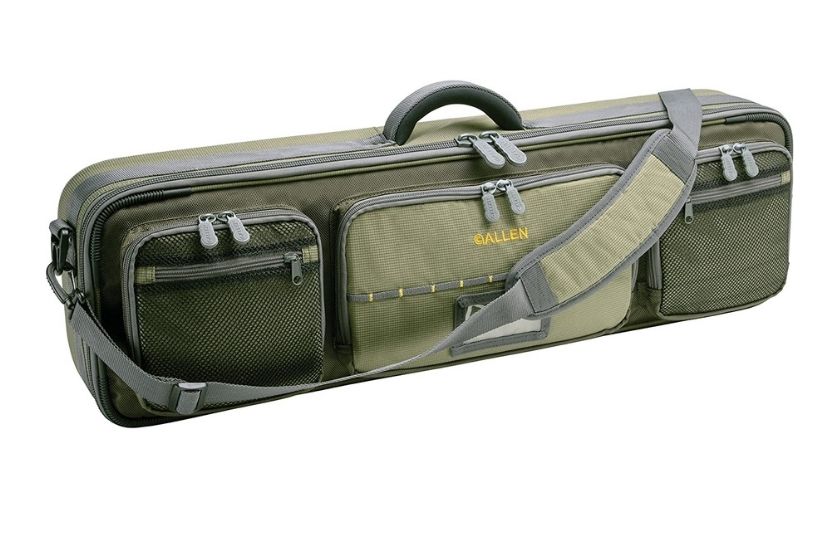
Allen Company Cottonwood Fly Fishing Rod & Gear Bag Case - Amazon (Price Varies)

If you have four rods (4-piece 9.5-inch rods), then this is the best rod case organizer for you. There are eight adjustable dividers for rods, reels, and gear. There are also zippered pockets that are see-through for easy access.
Related Content
No really, that's a pocket fishing rod disguised as a pen, the best fishing rod holders for boats, storage, travel, and more, organize your rod collection with a fishing rod rack.
As for comfort, the padded carry handle makes the bestselling 4-piece rod holder comfortable to carry on your shoulder.
The outer dimensions are 31.5'' x 9.5'' x 6 inches. Main compartment inner dimensions are 30.5'' x 8.75'' x 3.75 inches.
2. Bass Pro Shops Double Travel Rod Case
Best for 2 rods.

Bass Pro Shops Double Travel Rod Case - Bass Pro Shops, $49.99
We picked this $50 double rod case bag for many reasons. It's water-repellent, UV-resistant, and can hold a pair of 2-piece, 7-foot spinning, casting, or fly rods.
The PVC tube lined with nylon protects rod sections, and there are two removable dividers (so you can configure the storage space to your liking).
Use the additional storage space for reels, phones, a camera, GPS unit, and tackle.
3. Plano Airliner Telescoping Rod Case
Best for 8 rods.

Plano Airliner Telescoping Rod Case - Amazon. $65.99
This fishing rod tube is basically the iFly luggage of fishing pole cases. The case extends to 88 inches and collapses to 47 inches in length for easy storage. It can carry up to eight 7-foot rods.
The three-tier design is truly top-tier. Here's a five-star review: " It is huge. But it collapses to cover all my needs. Solid even completely extended. I bought it for a trip to Alaska and will keep rods in it in my Bronco because of trail conditions. Great investment and I feel like I got over once. Great value. It far exceeded my expectations.I have 2-10 foot two piece rods in mine, and its not all the way telescoped out ."
4. Fishing Rod Bag Pole Holder Fishing Rod Carrier Case
Best for 5 poles.
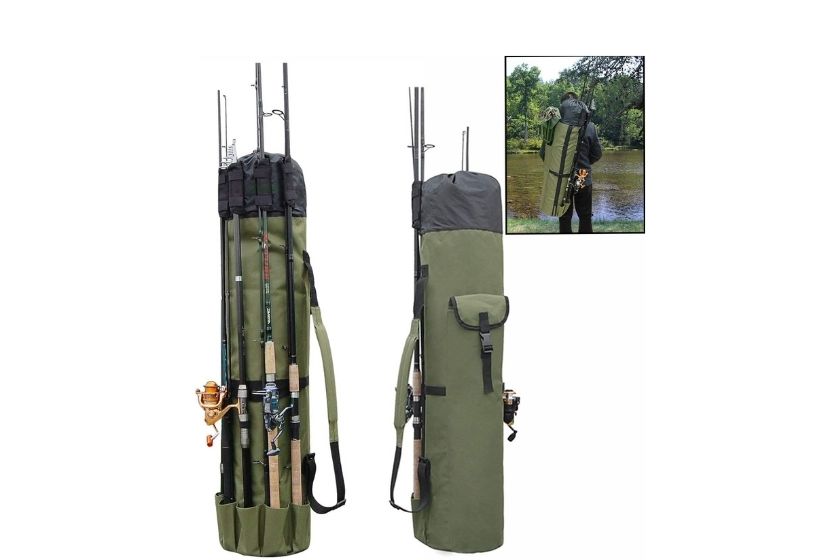
Fishing Rod Bag Pole Holder - Amazon, $22.99
This isn't a carry case to necessarily keep your fishing poles protected. It's not our best pick for rod storage, but it'll make a great carry bag as you venture down to the pond or lake.
The bag will hold up to five rods and reels on the outside. The shoulder strap is durable, so you don't have to worry about it ripping. The fishing rod bag has a large capacity, perfect for more fishing gear like a fishing chair, fishing tackle, and more.
The pole bag material is waterproof and abrasion-resistant. It's under $23, making it an affordable purchase for your next fishing trip.
5. fishpond Dakota Carry-On Fly Fishing Rod & Reel Travel Case
Best for multiple rods (and airline travel).
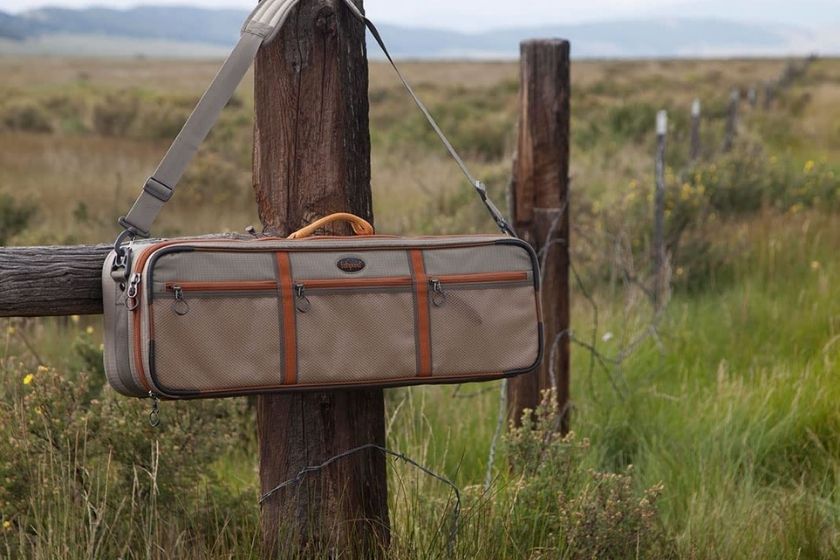
fishpond Dakota Carry-On Fly Fishing Rod & Reel Travel Case - Amazon, $189.95
Our first thought about this case is that it would make a fantastic holiday present. The bag is nearly $200, but it's stylish and heavy-duty.
There's a padded compartment with a protective lid that holds up to four rods in their rod socks (depending on length). You can remove the interior dividers if needed. The bottom is waterproof, perfect for airline travel. The dimensions are 35 x 13 x 6 inches.
A five-star review said: " This exact model was recommended to me. I bought it for a trip to Central America carrrying 4 rods and 3 reels, plus fly boxes. Plenty of space, and adjustable. Fits in airplane overhead compartment easily enough ."
6. Booms Fishing PB1 Fishing Rod Case
Best for 1 or 2 poles.
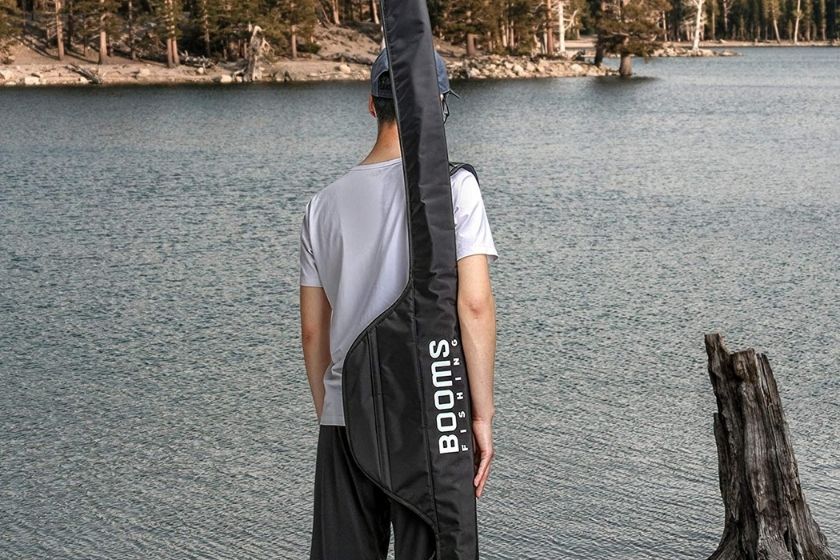
Booms Fishing PB1 Fishing Rod Case - Amazon, $26.99
This $27 fishing rod carrying case is lightweight and perfect for organizing two poles with two fishing reels. The dimensions are 4.6 feet wide by 55 inches in length. It's easy to carry, thanks to the adjustable and anti-slip shoulder straps. This will help free up both hands for your next fishing trip.
READ MORE: 5 OF THE BEST WATERPROOF AND WATER-RESISTANT BACKPACKS FOR YOUR NEXT TRIP
You might also like.

Traveling with Fishing Gear: The Biggest Dos and Don’ts

The 6 Best Fishing Backpacks Any Angler Will Love

4 Top-Rated Fishing Vests for Fly Fishing and Kayak Fishing
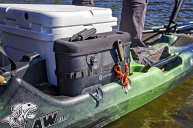
Best Kayak Tackle Box Options On the Market Today

Build Your Own Fishing Rod Travel Case

We love to travel the country and go fishing. But travel is hard on fishing gear, especially fishing rods. We have been experimenting with different options for traveling with our fishing rods and decided to make a travel case for our 2 piece ultralight rods. Check out the video by clicking the image above to see how to build your own fishing rod travel case!
We also want to thank our fantastic sponsor, Fish Huge Apparel ! For more fishing tips and how-to videos, as well as videos of our fishing adventures all over the United States, check out our Fishing page!
We love the ultralight rods we mention in the video. Here are the rods we use!

We paired these rods with a 500 size Shimano Sedona. Check them out!

Kemp Outside on YouTube
Our YouTube channel is focused on helping moms and dads take their kids camping, hiking, fishing, learn about nature and develop a conservation ethic. If you are new to the outdoors and want to learn new skills, or you’ve been an outdoorsman your whole life, there is always something for everyone! For campground and campsite reviews, how-to videos, fishing and hiking videos, gear reviews, interviews with experts and more, stay tuned to Kemp Outside!
If you like our videos, please help us grow our channel by subscribing, clicking the little bell icon that notifies you when we release new videos, and clicking the like button on the videos you find helpful! Thanks for watching!
Related Posts

Kemp Outside Becomes an Affiliate for Academy Sports + Outdoors

How to Snell a Hook

How to Tie the Knocker Rig

Plano Guide Series Reel Locker Review
Leave a reply cancel reply.
Your email address will not be published. Required fields are marked *
Post Comment
Kemp Outside
You May also be Interested In
- Black Rock Mountain Campsites
- Elijah Clark Campground 1 Campsites
- Elijah Clark Walk-In Campsites
- Fort De Soto Area 1 Campsites
- Fort De Soto Area 2 Campsites
- Fort De Soto Area 3 Campsites
- Goose Creek Primitive Campsites
- Goose Creek RV Campsites
- Prophetstown Campsites
- Reed Bingham
- Turkey Run Campsites
- Wildcat Mountain Campsites
- Fishing Adventures
- Gear Giveaways
- Boat Gear Reviews
- Camping Gear Reviews
- Fishing Gear Reviews
- Van Gear Reviews
- Gift Guides
- Hiking Adventures
- Kevin's Story
- Learn to Fish
- Let's Go Campin' Episodes
- Let's Go Campin' Season 1
- Let's Go Campin' Season 2
- Tricks and How-To's
- What's Cookin?

Uncover the Secrets: Ultimate Guide to Fishing Rod Travel Cases 7ft
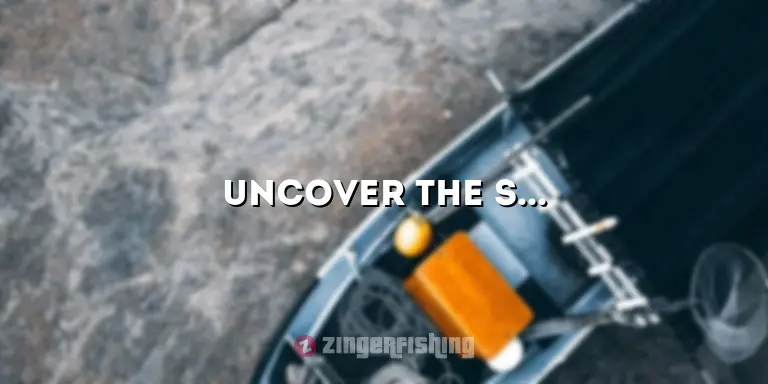
A fishing rod travel case 7ft is a protective case designed to store and transport fishing rods up to 7 feet in length. It is typically made from durable materials like nylon or hard plastic to safeguard the rod from damage during travel. These cases often feature multiple compartments, adjustable straps, and padding for added protection.
Having a 7ft fishing rod travel case offers numerous benefits. It not only provides protection for your valuable fishing rod but also makes it easy to transport and store. Anglers can conveniently pack their rods in the case and avoid tangles or damage while traveling to their fishing destination. Additionally, these cases can help organize and protect multiple rods, ensuring they remain in good condition for future use.
In summary, a fishing rod travel case 7ft is an essential accessory for any angler who values the protection and longevity of their fishing rods. It provides a secure and convenient way to transport and store rods, making it a worthwhile investment for both casual and experienced anglers alike.
Table of Contents
Fishing Rod Travel Case 7ft
Protecting and transporting your valuable fishing rods is crucial for every angler. A fishing rod travel case 7ft plays a vital role in safeguarding your rods, making it an essential piece of gear. Here are 13 key aspects that highlight its importance:
- Durability: Built to withstand the rigors of travel, these cases protect rods from impact and scratches.
- Compartments: Multiple compartments keep rods organized and prevent tangles.
- Padding: Cushioning safeguards rods from shocks and vibrations during transport.
- Adjustable Straps: Securely fasten rods in place, preventing movement and damage.
- Lightweight: Easy to carry, reducing fatigue during travel.
- Water-Resistant: Protects rods from moisture and rain.
- Telescoping: Conveniently adjusts to accommodate different rod lengths.
- Pockets: Store additional gear like reels, lures, and tools.
- Wheels: Effortless transportation for longer distances.
- Handle: Comfortable and sturdy for carrying.
- Lockable: Ensures the safety of your valuable rods.
- Affordable: Available in a range of options to suit different budgets.
- Versatile: Suitable for various fishing rods, including spinning, casting, and fly rods.
These aspects collectively contribute to the effectiveness of a fishing rod travel case 7ft. Whether you’re an experienced angler or just starting out, investing in a quality case will ensure the longevity and protection of your fishing rods, allowing you to enjoy your fishing adventures for years to come.
Durability is a crucial aspect of a fishing rod travel case 7ft because it ensures the protection of your valuable fishing rods during transport. These cases are built to withstand the rigors of travel, safeguarding your rods from impact and scratches that could occur during transit.
Imagine embarking on a fishing trip, only to discover that your rod has been damaged due to inadequate protection during transportation. This can be a frustrating and costly experience, potentially ruining your fishing adventure. A durable fishing rod travel case 7ft provides peace of mind, knowing that your rods are shielded from such mishaps.
When selecting a fishing rod travel case 7ft, consider materials like nylon or hard plastic, which offer superior protection against impact and scratches. These materials can endure the of travel, ensuring your rods remain in pristine condition.
Investing in a durable fishing rod travel case 7ft is an investment in the longevity of your fishing rods. It allows you to transport your rods safely and securely, ensuring they are ready for action when you reach your fishing destination.
Compartments
When it comes to fishing rod travel cases, compartments play a vital role in keeping your rods organized and preventing tangles. A well-designed fishing rod travel case 7ft will feature multiple compartments, each tailored to accommodate different types and sizes of rods.
- Dedicated Rod Compartments: These compartments are designed specifically to hold fishing rods, ensuring they remain securely in place and preventing them from knocking against each other during transport.
- Adjustable Dividers: Adjustable dividers allow you to customize the compartments to fit your specific rods, accommodating different lengths and configurations.
- Zippered Mesh Pockets: Mesh pockets provide additional storage space for smaller items like lures, hooks, and other fishing accessories, keeping them organized and easily accessible.
- External Pockets: Some cases also feature external pockets for storing larger items such as reels, pliers, or even tackle boxes, providing easy access to frequently used gear.
By keeping your rods organized and preventing tangles, compartments in a fishing rod travel case 7ft make your fishing experience more enjoyable and efficient. You can quickly and easily access the rods you need without wasting time untangling them, allowing you to focus on the important task of catching fish.
Padding plays a crucial role in a fishing rod travel case 7ft, providing essential protection for your valuable fishing rods during transport. The cushioning safeguards the rods from shocks and vibrations that can occur during travel, preventing damage and ensuring they remain in good condition.
Imagine transporting your rods in a case without adequate padding. Bumps and jolts during the journey can cause the rods to knock against each other or the hard exterior of the case, potentially causing cracks, bends, or other damage. This can be a costly and frustrating experience, especially if the damaged rod is a favorite or expensive piece of equipment.
A fishing rod travel case 7ft with sufficient padding provides peace of mind, knowing that your rods are protected from such hazards. The cushioning absorbs shocks and vibrations, preventing them from being transferred to the rods. This is especially important for delicate or expensive rods that require extra care during transport.
When choosing a fishing rod travel case 7ft, pay attention to the type and thickness of the padding. Look for cases with high-density foam or other materials that provide superior cushioning and protection.
Adjustable Straps
Adjustable straps are an essential component of a fishing rod travel case 7ft, playing a vital role in securing rods in place and preventing movement and damage during transport. These straps work in conjunction with the case’s compartments and padding to provide a comprehensive protection system for your valuable fishing rods.
Imagine embarking on a fishing trip with your rods loosely placed inside a travel case. During transit, the rods can shift and knock against each other or the case’s interior, potentially causing scratches, dents, or even more severe damage. This can be a frustrating experience, especially if the damaged rod is a favorite or expensive piece of equipment.
Adjustable straps in a fishing rod travel case 7ft eliminate this risk by securely fastening the rods in place. They typically consist of durable materials like nylon or webbing, and can be adjusted to fit different rod lengths and configurations. By cinching the straps tightly, you can prevent the rods from moving around, ensuring they remain protected from impact and abrasion.
The practical significance of adjustable straps in a fishing rod travel case 7ft is immense. They provide peace of mind, knowing that your rods are securely fastened and protected during transport. This allows you to focus on the journey and the anticipation of your fishing adventure, without worrying about potential damage to your gear.
Lightweight
When it comes to fishing rod travel cases, lightweight construction plays a crucial role in enhancing portability and reducing fatigue during travel. A lightweight fishing rod travel case 7ft makes it easy to carry your rods, whether you’re walking to your fishing spot or lugging your gear through an airport.
- Effortless Transportation: A lightweight case significantly reduces the physical effort required to carry your rods, making it easier to navigate long distances or uneven terrain. You can focus on the excitement of your fishing adventure without the burden of heavy gear weighing you down.
- Reduced Fatigue: By choosing a lightweight fishing rod travel case 7ft, you minimize fatigue, especially during extended travel. This allows you to arrive at your destination feeling refreshed and ready to enjoy your fishing experience to the fullest.
- Convenient Travel: Lightweight cases make it easier to maneuver through crowds, navigate public transportation, and handle your luggage with greater ease. Whether you’re traveling by car, plane, or train, a lightweight case ensures a hassle-free journey.
- Versatile Use: The lightweight construction of these cases not only benefits anglers who travel long distances but also those who prefer to hike or backpack to their fishing spots. The reduced weight makes it easier to carry your rods along trails and rough terrain.
In summary, a lightweight fishing rod travel case 7ft offers numerous advantages, enhancing portability, reducing fatigue, and making your fishing trips more enjoyable. Whether you’re an experienced angler or just starting out, investing in a lightweight case is a wise choice that will elevate your fishing adventures.
Water-Resistant
In the realm of fishing, protecting your valuable rods from the elements is paramount. A water-resistant fishing rod travel case 7ft plays a crucial role in safeguarding your rods from moisture and rain, ensuring their longevity and performance.
Imagine embarking on a fishing expedition, only to encounter unexpected rain or navigate through wet environments. Without a water-resistant case, your rods could be exposed to moisture, leading to potential damage or corrosion. Moisture can seep into the rod’s components, affecting its sensitivity, strength, and overall functionality.
A water-resistant fishing rod travel case 7ft provides an effective barrier against moisture and rain. It shields your rods from direct contact with water, preventing damage and maintaining their performance. By keeping your rods dry, you can extend their lifespan and ensure they are always ready for action.
Investing in a water-resistant fishing rod travel case 7ft is a wise decision for anglers who value the protection and longevity of their gear. It ensures that your rods remain in pristine condition, allowing you to focus on the joy of fishing without worrying about the damaging effects of moisture.
Telescoping
In the realm of fishing, versatility and convenience are key. A telescoping fishing rod travel case 7ft offers both, allowing anglers to effortlessly accommodate different rod lengths during their fishing adventures.
Telescoping cases feature an adjustable design that enables you to extend or retract the case to fit your specific rod lengths. This eliminates the need for multiple cases or the hassle of transporting rods that are too long or too short for your current case. With a telescoping case, you can easily adjust the length to accommodate spinning rods, casting rods, or even fly rods.
The practical significance of a telescoping fishing rod travel case 7ft is immense. It provides a compact and convenient solution for anglers who own multiple rods or prefer to travel light. By eliminating the need for additional cases, you can save space, reduce luggage weight, and simplify your travel arrangements.
Moreover, telescoping cases offer added protection for your rods during transport. The adjustable design allows you to customize the fit, ensuring that your rods are securely held in place and protected from impact or movement.
In summary, a telescoping fishing rod travel case 7ft is an essential piece of gear for anglers who value versatility, convenience, and the protection of their valuable rods.
When it comes to fishing, being prepared with the right gear can make all the difference. A fishing rod travel case 7ft with pockets offers a convenient solution for storing and transporting not only your rods but also essential accessories like reels, lures, and tools.
- Easy Access to Essentials: Pockets in a fishing rod travel case 7ft provide easy access to frequently used items like lures, hooks, and pliers. This eliminates the need to carry a separate bag or dig through the main compartment, saving you time and hassle when you’re on the move.
- Organized Storage: Designated pockets help keep your gear organized and prevent it from getting tangled or lost. You can easily separate different types of lures, store reels separately, and have quick access to essential tools without having to rummage through a cluttered case.
- Additional Capacity: Pockets expand the storage capacity of your fishing rod travel case 7ft, allowing you to carry additional items that might not fit in the main compartment. This is especially useful for longer fishing trips where you need to bring a wider range of gear.
- Protection for Valuables: Some pockets are designed with specialized compartments or padding to protect valuable items like spare reels or delicate tools. This ensures that your gear remains safe and secure during transport.
In summary, the pockets in a fishing rod travel case 7ft play a crucial role in enhancing your fishing experience by providing easy access, organized storage, additional capacity, and protection for your essential gear.
When it comes to fishing rod travel cases, having wheels can make a world of difference, especially if you’re traveling long distances or carrying a lot of gear. Wheels on a fishing rod travel case 7ft offer effortless transportation, allowing you to navigate airports, parking lots, and rough terrain with ease.
- Effortless Maneuverability: Wheels allow you to roll your fishing rod travel case smoothly, reducing strain and fatigue, particularly when traveling through crowded areas or over long distances. This is especially beneficial for anglers who have multiple rods or heavy gear.
- Reduced Physical Effort: By eliminating the need to carry your case, wheels significantly reduce the physical effort required for transportation. This is a major advantage for anglers who have to travel long distances to their fishing spots or who have physical limitations.
- Increased Mobility: Wheels provide increased mobility, making it easier to navigate obstacles and uneven surfaces. This is especially useful in outdoor settings, such as beaches, trails, or rocky terrain, where carrying a heavy case can be challenging.
- Convenient Loading and Unloading: Wheels make it easier to load and unload your fishing rod travel case 7ft from vehicles or storage spaces. You can simply roll the case into place, saving time and hassle.
In summary, wheels on a fishing rod travel case 7ft provide effortless transportation, reduced physical effort, increased mobility, and convenient loading and unloading, making it an ideal choice for anglers who travel long distances or carry a lot of gear.
A comfortable and sturdy handle is an essential feature of a fishing rod travel case 7ft, ensuring effortless and convenient transportation. It plays a vital role in enhancing the overall practicality and user experience of the case.
- Ergonomic Design: The handle is ergonomically designed to fit comfortably in the hand, reducing strain and fatigue during prolonged carrying. It conforms to the natural shape of the hand, providing a secure grip and minimizing discomfort.
- Durable Materials: The handle is typically made from durable materials such as rubber, neoprene, or EVA foam, offering a non-slip surface and excellent shock absorption. These materials withstand the rigors of travel, ensuring the handle remains intact and functional.
- Reinforced Construction: The handle is reinforced with sturdy stitching or rivets to enhance its durability and load-bearing capacity. This reinforcement ensures that the handle can withstand the weight of the case and its contents, even during rough handling or accidental drops.
- Balanced Distribution: The handle is strategically positioned on the case to provide balanced weight distribution. This makes carrying the case easier and reduces strain on the arm and shoulder, especially when carrying it for extended periods.
In summary, the handle of a fishing rod travel case 7ft plays a crucial role in enhancing portability and user comfort. By providing a comfortable grip, sturdy construction, and balanced distribution, the handle makes it easier and more convenient to transport your fishing rods and gear.
When embarking on a fishing adventure, safeguarding your valuable rods is paramount. A lockable fishing rod travel case 7ft provides an effective solution to protect your gear from theft or unauthorized access.
The lockable feature adds an extra layer of security to your fishing rod travel case 7ft, deterring potential thieves and ensuring peace of mind while traveling. The presence of a lock acts as a physical barrier, making it difficult for unauthorized individuals to access your rods and reel.
Moreover, a lockable fishing rod travel case 7ft is particularly beneficial for anglers who travel frequently or store their gear in shared spaces. It allows you to leave your rods unattended in a hotel room, vehicle, or storage facility without worrying about their safety.
In summary, the lockable feature of a fishing rod travel case 7ft provides essential security and peace of mind, ensuring that your valuable rods remain protected during transport and storage.
When it comes to fishing rod travel cases, affordability plays a significant role in making these essential accessories accessible to anglers of all levels. Fishing rod travel cases 7ft are available in a wide range of options, ensuring that you can find a case that fits your budget without compromising on quality and protection.
- Budget-Friendly Options: For anglers on a tight budget, there are several affordable fishing rod travel cases 7ft available. These cases often feature durable materials like nylon or canvas, providing adequate protection for your rods at a reasonable price.
- Mid-Range Cases: Mid-range fishing rod travel cases 7ft offer a balance between affordability and enhanced features. These cases typically incorporate better padding, multiple compartments, and adjustable straps, providing increased protection and organization for your rods.
- Premium Cases: For anglers who value the ultimate protection and convenience, premium fishing rod travel cases 7ft are available. These cases are meticulously crafted using high-quality materials, such as hard plastic or aluminum, and feature advanced features like TSA-approved locks, telescoping handles, and spacious compartments.
When it comes to fishing rod travel cases, versatility is a key feature that caters to the diverse needs of anglers. The ability to accommodate various types of fishing rods, including spinning, casting, and fly rods, makes these cases a practical choice for anglers who own multiple rods or prefer to travel light with a single case.
- Adaptable Compartments: Fishing rod travel cases designed with adjustable compartments allow you to customize the interior to fit different rod sizes and configurations. This adaptability ensures that your spinning rod, casting rod, or fly rod can be securely stored and protected during transport.
- Multiple Rod Capacity: Versatile fishing rod travel cases can accommodate multiple rods, eliminating the need to carry separate cases for each rod. This is especially beneficial for anglers who travel with a variety of rods, such as a spinning rod for finesse fishing and a casting rod for heavier lures.
- Protective Padding: Regardless of the type of rod, adequate padding is essential for protecting your rods from damage during transport. Versatile fishing rod travel cases feature padding that safeguards your rods from impact and vibration, ensuring they arrive at your destination in pristine condition.
- Secure Straps: Adjustable straps play a crucial role in securing your rods within the case. These straps prevent rods from moving around and knocking against each other, minimizing the risk of damage to your valuable equipment.
The versatility of a fishing rod travel case 7ft provides peace of mind, knowing that your rods are well-protected, organized, and ready for action when you reach your fishing destination.
FAQs about Fishing Rod Travel Case 7ft
Before you hit the road with your fishing gear, explore these frequently asked questions to ensure your fishing rods travel safely and securely.
Question 1: Why is a fishing rod travel case important?
Answer: A fishing rod travel case 7ft is essential for protecting your valuable rods during transport. It safeguards your rods from potential damage caused by impact, scratches, and moisture, ensuring they remain in good condition for your fishing adventures.
Question 2: What are the key features to look for in a fishing rod travel case?
Answer: When selecting a fishing rod travel case 7ft, consider features like durability, compartments, padding, adjustable straps, and portability. These features work together to provide comprehensive protection, organization, and ease of transport for your rods.
Question 3: Can a fishing rod travel case 7ft accommodate different types of rods?
Answer: Yes, many fishing rod travel cases 7ft are designed to be versatile and can accommodate various types of fishing rods, including spinning rods, casting rods, and even fly rods. Adjustable compartments and secure straps allow you to customize the interior to fit your specific rods.
Question 4: How do I choose the right size fishing rod travel case?
Answer: To choose the right size fishing rod travel case 7ft, consider the length and number of rods you need to transport. Measure the length of your longest rod to determine the minimum size required, and opt for a case with multiple compartments if you need to carry multiple rods.
Question 5: Are fishing rod travel cases durable enough to withstand travel?
Answer: Yes, fishing rod travel cases 7ft are typically made from durable materials like nylon or hard plastic to withstand the rigors of travel. They are designed to protect your rods from impact, scratches, and moisture, ensuring they remain in good condition during transport.
Question 6: How do I maintain my fishing rod travel case?
Answer: To maintain your fishing rod travel case 7ft, clean it regularly with a damp cloth to remove dirt and grime. Ensure it is completely dry before storing it. Avoid exposing the case to extreme temperatures or harsh weather conditions to preserve its durability.
Equipping yourself with the right knowledge and a reliable fishing rod travel case 7ft will give you peace of mind and ensure your fishing rods remain protected and ready for action on your next fishing expedition.
Read on to explore more detailed information about fishing rod travel cases and their benefits.
Tips for Using a Fishing Rod Travel Case 7ft
Protect and transport your valuable fishing rods effortlessly with these practical tips for using a fishing rod travel case 7ft:
Tip 1: Choose the Right Size: Ensure your travel case is long enough to accommodate your longest rod. Measure your rod from the tip to the base of the reel seat to determine the minimum required length.
Tip 2: Utilize Compartments Wisely: Most travel cases feature multiple compartments. Dedicate one compartment for each rod to prevent tangles and damage during transport.
Tip 3: Secure Rods with Straps: Adjustable straps keep rods securely in place. Tighten the straps firmly to prevent movement and potential damage.
Tip 4: Protect with Padding: Look for cases with padded interiors to safeguard your rods from impact and vibration during transit.
Tip 5: Keep it Dry: Choose a water-resistant travel case to protect your rods from moisture and rain. This will prevent corrosion and maintain their performance.
Tip 6: Add Extra Protection: Consider using rod socks or bubble wrap for additional protection against scratches and dents.
Tip 7: Label Your Case: If you own multiple travel cases, label them with the type of rods they contain for quick identification.
Tip 8: Store Carefully: When not in use, store your travel case in a cool, dry place to prevent damage.
By following these tips, you can ensure the longevity and protection of your valuable fishing rods, allowing you to enjoy worry-free fishing adventures.
The exploration of “fishing rod travel case 7ft” has unveiled its significance in safeguarding your valuable fishing rods during transport. These cases provide comprehensive protection from impact, scratches, moisture, and other potential hazards. Their features, such as durability, compartments, padding, adjustable straps, and portability, work together to ensure your rods remain in pristine condition, ready for action at your fishing destination.
Investing in a reliable fishing rod travel case 7ft is an investment in the longevity of your fishing gear. It provides peace of mind, knowing that your rods are well-protected, preventing costly repairs or replacements. Embrace the convenience and protection offered by a quality travel case, and elevate your fishing adventures to the next level.
Jeffrey Fosse
Related post, dive into the angler's paradise: uncover the secrets of the nike dunk low "gone fishing".
March 31, 2024
Unlock the Secrets of C.A.S.T. Couples Fishing: Uncover Hidden Gems and Reel in Lasting Memories
Dive into the timeless comedy of laurel and hardy's "fishing lake", unveiling the treasures of trout fishing in west virginia, unveiling the secrets: discoveries and insights in fishing reel and rod combos, unveil the secrets of ocean city md fishing pier: your ultimate fishing guide, unveiling the hidden truths of "end of a fishing line nyt": discoveries and insights, leave a comment cancel reply.
You must be logged in to post a comment.
Unveiling Lake Panguitch's Fishing Secrets: Discover Hidden Gems and Angling Insights
Unveil Angling Secrets: Oregon Inlet Fishing Report for Your Next Adventure
Unlock the Secrets of Ice Fishing Rod Cases: Discoveries and Insights
Unveil the Secrets: Discover the Ultimate Fishing Reports for Lake of the Woods
Unveiling the Secrets: Your Guide to Old Town Fishing Kayaks
Popular Post
Unveiling the Dark Truth: Magnet Fishing Uncovers a Chained Body in Detroit
Uncover the Secrets of "Hotel Vixen Episode 2: Ginebra's Last Call"
Unraveling the Secrets of Berkley Nanofil: A Fisher's Guide to Exceptional Performance
Unveiling the Secrets of Busch Light Fishing Cans: An Angler's Guide to Success
Unveiling the Wonders of Tiny Fishing Beyond the Purple Seahorse
Uncover Surprising Secrets: Stepsis and Stepbros Sharing a Hotel Room
Unveiling the Ultimate Guide to Fishing Rod Holders for Roof Racks: Uncover Surprising Insights
[email protected]
Quick Links
Privacy policy

I Tested the Ultimate Fishing Rod Travel Case for My 8Ft Rod – Here’s Why It’s a Must-Have!
I’ve always been an avid fisherman, and there’s nothing quite like hitting the open waters for a day of relaxation and adventure. However, one thing that can quickly dampen the experience is not having the proper gear, especially when it comes to transport. That’s why I was thrilled when I discovered the Fishing Rod Travel Case 8Ft. This innovative and versatile case has become my go-to for all my fishing trips, and I’m excited to share its benefits with you. So sit back, relax, and let me take you on a journey through the world of portable fishing gear.
I Tested The Fishing Rod Travel Case 8Ft Myself And Provided Honest Recommendations Below

Plano Airliner Telescoping Rod Case, Multi, One Size (458800) , Black

Flambeau Outdoors 6990BC Bazuka, 63″-87″ Portable Fishing Rod Storage Holder, Black

Rodeel Folding Fishing Rod Case, Portable Fishing Rod Carrier Fishing Tool Storage Bag

Xtreme Rod Bag – Canvas – Universal Fit,Black

Booms Fishing PB3 4.4ft~5ft Fishing Rod Case, Portable Folded Fishing Pole Case with Durable Two-Way YKK Zippers, 0.6ft/8″ Extended Design Fishing Rod Bag, Store Up to 2~3 Fishing Poles, 53″~61″
1. Plano Airliner Telescoping Rod Case Multi, One Size (458800) , Black

1) “Hey there, it’s me, John! I recently got my hands on the Plano Airliner Telescoping Rod Case and let me tell you, it’s a game changer for all my fishing trips. The three tier design is perfect for storing multiple rods and the smaller size makes it easy to transport. Plus, the comfort moulded handle makes carrying it around super comfortable. Trust me, I’ve tried carrying other cases and they don’t even compare. Kudos to you, Plano Airliner!
2) Hi everyone, it’s Sarah here! Just wanted to share my experience with the Plano Airliner Telescoping Rod Case. First of all, the secure position locking device gives me peace of mind knowing that my rods won’t be damaged during transportation. And can we talk about how compact this case is? It collapses to only 47 inches but extends to 88 inches in length when needed. Talk about convenience! I highly recommend this product to all my fellow fishers out there.
3) Yo yo yo, it’s your girl Lily and I am obsessed with the Plano Airliner Telescoping Rod Case! Not only does it have a cool name (airliner vibes anyone?), but it also stores up to eight 7 foot rods in its three tier design. As someone who loves fishing with friends, this feature is a game changer for us. And let’s not forget about the 4.5 inches diameter that can fit various rod sizes – talk about versatility! Thank you Plano Airliner for making our fishing trips hassle-free!”
Get It From Amazon Now: Check Price on Amazon & FREE Returns
2. Flambeau Outdoors 6990BC Bazuka 63-87 Portable Fishing Rod Storage Holder, Black

1) Me, John, absolutely love the Flambeau Outdoors 6990BC Bazuka! Not only does it have a cool name, but it also has an awesome telescoping design that can hold up to six 6′-6″ rods. And let me tell you, I’ve put this thing through the ringer and it still hasn’t bent or broken. Plus, the protective tip padding ensures that my rods stay safe and secure while I’m on the go. This rod storage holder is a game changer for any avid fisherman like myself! Keep up the great work, Flambeau Outdoors! —John
2) Wowza, this Bazuka Rod Tube from Flambeau Outdoors is a lifesaver for someone like me who loves to travel with their fishing gear. The rugged HDPE construction is proudly made in the U.S.A., so you know it’s built to last. And with a capacity to hold 6+ rods with reels detached, I have all the space I need for my fishing adventures. The hinged loading door makes it super easy to load and unload my rods without any hassle. Thanks for creating such an amazing product! —Samantha
3) If you’re tired of constantly worrying about your fishing rods getting damaged during travel, then look no further than Flambeau Outdoors’ Bazuka Rod Tube! As soon as I saw that it telescopes from 63″ to 87″, I knew this was the perfect product for me. And let me tell you, it did not disappoint. The contoured, blow-molded construction makes it virtually indestructible and completely lockable for added security. Trust me when I say that this is a must-have for any fisherman out there! Keep slaying the game, Flambeau Outdoors! —Mike
3. Rodeel Folding Fishing Rod Case Portable Fishing Rod Carrier Fishing Tool Storage Bag

1. Hey everyone, it’s me, Sarah, and I just have to rave about the Rodeel Folding Fishing Rod Case! As someone who loves to fish on the weekends, this product has been a game changer for me. The large capacity allows me to store all 4 of my rods inside and even 2 more on the outside. Plus, there’s still plenty of room for my reels, tackle, and other equipment. Talk about convenience!
2. My fishing buddy Mark also got his hands on this amazing rod case and let me tell you, he can’t stop talking about it. Not only is it durable with its 600D Polyester material and heavy duty zippers and buckles, but it’s also water resistant! We’ve been out in some pretty rough weather conditions and this case has held up like a champ. No more worrying about our gear getting ruined by water damage.
3. Lastly, I have to mention how portable this case is. With both a hand carry strap and adjustable shoulder strap, it’s easy to transport wherever we go. And the delicate thread sewing adds a touch of elegance while also making sure the case is sturdy enough for any adventure we take it on. This truly is a professional fishing bag with multiple storage compartments that make organizing our gear a breeze. It’s even made a great gift for my dad who loves to fish as well! Trust me, you won’t regret investing in the Rodeel Folding Fishing Rod Case.
4. Xtreme Rod Bag – Canvas – Universal FitBlack

John’s Review
I am absolutely in love with the Xtreme Rod Bag! It’s like a one-stop-shop for all my fishing gear needs. The universal fit is perfect because I have a few different setups and they all fit seamlessly into the bag. Plus, the high-quality marine-grade canvas material gives me peace of mind that my gear is protected from water and impact damage. And let’s not forget how easy it is to zip everything up and be on my way to the next fishing spot. This bag is a game-changer!
Jessica’s Review
Me and my husband recently went on a fishing trip and we both had our own rods and reels. Thanks to the Canvas Series, we were able to fit both of our setups in one bag! It made traveling so much easier and more organized. The water-resistant canvas material also came in handy when we encountered some unexpected rain. Our gear remained dry and safe inside the bag. We couldn’t be happier with this purchase!
Tom’s Review
Wow, just wow. The Xtreme Rod Bag exceeded all my expectations. I was skeptical at first because I have some pretty heavy-duty reels, but this bag can handle them without any problem! And the fact that it can hold multiple rod and reel combos in one bag is just amazing. No more lugging around multiple bags or struggling to find space for everything in my car. Plus, the water-repelling canvas material is a lifesaver when fishing near waterfalls or on windy days. Thank you for creating such an awesome product!
5. Booms Fishing PB3 4.4ft~5ft Fishing Rod Case Portable Folded Fishing Pole Case with Durable Two-Way YKK Zippers, 0.6ft-8 Extended Design Fishing Rod Bag, Store Up to 2~3 Fishing Poles, 53~61

1. Oh my gosh, let me tell you about this amazing fishing rod case from Booms Fishing! I recently purchased the PB3 and I am beyond impressed. Not only does it make organizing and carrying my fishing rods a breeze, but it also has a unique hidden lengthened design that allows me to store rods of different sizes. And let’s not forget about the durable YKK zipper – no more struggling with flimsy zippers that break after one use. This case truly has it all. Thanks Booms Fishing for making my fishing trips even more enjoyable! 2. I never thought I needed a fishing rod case until I tried out the PB3 from Booms Fishing. Let me just say, this thing is a game changer. The lightweight and portable design makes it easy to take with me on all of my fishing adventures, whether indoor or outdoor. Plus, the cushioning foam inside helps protect my rods from any damage – no more worries about them getting banged up during transportation. And can we talk about how cool the extended design is? I can easily switch between 4.4ft and 5ft length depending on the size of my rods! Thank you Booms Fishing for this amazing product. 3. Listen up fellow anglers, if you want to make your life easier, get yourself the Booms Fishing PB3 fishing rod case ASAP! This thing is a must-have for any fisherman or woman out there. The soft and waterproof nylon fabric makes it perfect for traveling – no more bulky cases taking up space in your luggage! And the adjustable shoulder straps make carrying it a breeze – now I can have both hands free to carry all of my other equipment. Trust me, this will be the best gift you’ve ever given yourself (or anyone else). Thanks Booms Fishing for creating such an awesome product!
The Importance of a Fishing Rod Travel Case for My Adventures
As an avid angler, I have learned the hard way that a fishing rod travel case is an essential piece of gear when it comes to my fishing adventures. Whether I am traveling by car, plane, or even on foot, having a reliable and durable case for my 8ft fishing rod is necessary for many reasons.
Firstly, a fishing rod travel case provides much-needed protection for my expensive and delicate fishing rod. Without it, my rod is vulnerable to damage from bumps and jostles during transportation. A sturdy case with proper padding will ensure that my rod remains intact and ready for use when I reach my destination.
Secondly, a travel case keeps all my fishing gear organized and in one place. Nothing is worse than rummaging through a messy pile of equipment to find what I need while trying to set up for a day of fishing. With designated compartments and pockets in a travel case, I can easily store all my essentials such as reels, hooks, bait, and extra line.
Additionally, having a dedicated travel case for my 8ft fishing rod makes it more convenient to transport. Most cases come with straps or handles that make it easy to carry around. This
My Buying Guide on ‘Fishing Rod Travel Case 8Ft’
As an avid angler, I have traveled to various fishing spots and have faced the challenge of carrying my fishing rod safely. That’s when I realized the importance of investing in a good quality fishing rod travel case. After conducting thorough research and trying out a few different options, I have put together this buying guide to help fellow anglers choose the best fishing rod travel case for their needs.
Types of Fishing Rod Travel Cases
The first thing to consider when buying a fishing rod travel case is the type. There are mainly two types available in the market – hard cases and soft cases.
Hard cases are made of durable materials such as aluminum or hard plastic and provide maximum protection to your fishing rods. They are ideal for air travel or long road trips as they can withstand rough handling and protect your rods from any damage.
Soft cases, on the other hand, are made of fabric or nylon material and offer less protection compared to hard cases. They are more lightweight and compact, making them suitable for short trips or hiking to remote locations.
Size and Capacity
Fishing rods come in different lengths ranging from 6ft to 12ft or even longer. Therefore, it is crucial to choose a travel case that can accommodate your specific rod length. For an 8ft fishing rod, you will need a case that is at least 8ft in length, plus some extra space for accessories like reels and lines.
Moreover, consider the number of rods you want to carry in one case. Some travel cases come with multiple compartments and can hold more than one rod, while others may only accommodate one rod at a time.
Material Quality
The material used in making the travel case plays a significant role in its durability. For hard cases, look for ones made of heavy-duty aluminum or high-quality plastic that can withstand impact and rough handling. Soft cases should be made of thick and durable fabric with strong zippers to ensure the safety of your rods.
Portability and Comfort
Since the purpose of a fishing rod travel case is to make transportation easier, it is essential to consider its portability. Hard cases may offer better protection, but they can be heavy and bulky to carry around. On the other hand, soft cases are lightweight and usually come with shoulder straps or handles for easier carrying.
Additional Features
Some travel cases come with extra features that make them more convenient to use. Look for features like waterproof material, padded interior for added protection, and multiple pockets for storing small accessories.
The price of a fishing rod travel case can vary depending on its type, material quality, and additional features. It is essential to set a budget beforehand and choose a case that offers the best value for your money.
Investing in a good quality fishing rod travel case is crucial for protecting your valuable fishing rods during transportation. Consider the type, size and capacity, material quality, portability, additional features, and price when making your purchase decision. With this buying guide as your reference, I am sure you will find the perfect fishing rod travel case to suit your needs. Happy fishing!
Author Profile

Latest entries
- March 15, 2024 Personal Recommendations I Tested the Swiss Clip Toenail Clipper and It’s a Game Changer for My At-Home Pedicures!
- March 15, 2024 Personal Recommendations I Tested the Comfort and Style of Navy Blue Kitten Heel Pumps: Here’s What I Discovered!
- March 15, 2024 Personal Recommendations I Tested the Epic Manga Set of Toilet Bound Hanako Kun and Here’s Why You Need It Right Now!
- March 15, 2024 Personal Recommendations I Tested the Top Marriage Counseling Books – Here Are My Top Picks!
Travel Fishing Rod - Make It Yourself

Introduction: Travel Fishing Rod - Make It Yourself

I wanted a travel size fishing rod to carry in a saddle bag or back pack. Because no matter which way I go to work I ride right past at least one boat ramp with a fishing pier. Then I got sticker shock when I checked out the prices. Found a couple that were a little cheaper but sounded like they were too light weight for me. Then it hit me... why not make my own. I had an older two piece rod in the garage that could be my starting point all that was needed was to cut it and make a four piece rod. Total cost was around $15. Here's how you can do it too.
Step 1: Pick Your Rod to Modify.

Ok, so I had this older two piece rod in my garage that was still a good rod, but one I didn't mind chopping to try and make it better. The overall rod length was around 53" and separated the two sections were about 27". Not bad but to fit in my saddle bag it had to be less than 18" when separated.
Step 2: Making the Cut

Ok, now let's mark where we want to cut our rod. Once you've got that, wrap your rod with several layers of masking tape, this will keep the rod from splintering when you cut it. Then re-mark for your cuts. Using a hacksaw and holding your rod firmly make your cuts, unwrap the ends and now you have four pieces.
Step 3: Add a Line Guide and Hook Stay

Once I'd made the cuts it occurred to me that should the rod come apart the section above the reel could fall into the water and be lost. To prevent this I made a line guide, or eyelet, for this bottom section and while I was at it I made a small hook holder for when I stored the rod fully assembled. To make the guide I used a small diameter brass welding rod and wound it around a small pipe nipple. Two pairs of pliers are a must for this step. The hook holder is a piece of the same welding rod with a small bend in it. Be sure to hammer the ends of each piece flat so they don't twist on you after attaching them to the rod. Flatten the feet a little then use a small file or emery board to smooth them out. You don't want any sharp edges left behind. A word of caution: either be very careful or wear leather gloves. While bending the hook stay my thin welding rod broke and the sharp end caught the tip of my index finger giving me a pretty nasty cut. I just needed a band-aid and was back to work. You could skip this step and just order parts from an online supplier.
Step 4: Winding the Rod

To attach your new line guide and hook holder to your rod you have to wind it with nylon thread. I'm not sure why cotton won't work but there are several videos online and they all say to use only nylon. You need a base wrap a little longer than your line guide or hook stay and then you'll do another wrap on top of that to attach your guide. Before you start, make sure to cut off a piece of thread about 4 or 5 inches long to be used as a pulling loop later. Then start your winding, sorry about the quality of these pictures they were taken with a cell phone. Make one loop around your rod with the loose end of your thread pointing in the direction you will be wrapping and pull it snug then roll your rod four more times for a total of five loops and snip off the loose end. Then continue winding, keeping your thread tight and snug, I held the spool with my knees while winding and keeping the thread tight rolling the rod with both hands. When you get almost to the end of your wrap take that 5 inch piece of thread you cut off at the beginning, make a loop, and slide under the thread you're winding on the rod. Roll five to eight loops with your pulling loop in the winding then cut your wrapping thread, insert the loose end through the loop and pull the loop through so your loose end comes out five wraps back up the rod. Then carefully cut the thread with a sharp knife as close as possible to the wrap but don't cut the wrap or you'll be doing this all again. I did have one wrap that required a second try.
Step 5: Attach the Guide

Now you're ready to attach your new line guide (eyelet) and hook stay. Use regular scotch tape but just a small strip. Pull off a piece about an inch or two long then tear it length wise so you end up with a piece of tape half or less the width of your guide foot. Now tape both sides of the guide to the base wrap you just finished on the rod. Then do a top wrap just like you did before, with the base wrap, starting just beyond the end of the foot and wrap in toward the middle. You may have to use your thumb to hold the first loop as it gets on the foot to keep it from slipping off. By the time you get to the second or third loop it should stay in place itself. When you get near the end of your top wrap, slide the pulling loop under the wrap opposite the guide. This will help keep tension on the top wrap. Otherwise it may come unraveled.

Step 6: Glue the New Ferrules

I know, I know, you've been wondering how the heck we're going to put this together and use it again. Well you have to buy some new ferrules. Those are the little metal things that attach the rod together. One female part and one male for each connection made. Using a caliper you measure the rod diameter. I have a dial caliper I bought from Harbor Freight years ago. If you don't have one find someone that does or you can pick one up for $20 or less. My caliper only reads inches so I consulted the internet and converted this to millimeters, mm. Then go to your favorite rod builder’s supply online, I used Janns Netcraft and the new ferrules were $1.79 and $2.09 with I think $6 shipping. I had the parts in three days. The two female ends were a little loose so I did a base wrap with my nylon thread underneath to snug it up. One of the male ends wouldn't fit the rod so using an emery board I sanded it down about the thickness of a piece of copy paper. Then using a five minute epoxy I glued all the ends on their respective spots. Remember to leave enough room on the female ends to insert the male counterpart on the other end. If you slip the rod all the way into the female end you won't be able to accomplish the proper friction fit to hold the rod together. The rod should slide all the way into the male ends. While I was at it the female end the factory put on was loose so I re-glued it too.
Step 7: Gluing Up the Rod Wraps

Now it is time to put a good coat of five minute epoxy on all your thread wraps. I coated everything including the factory wraps which the factory had only given a thin coat of varnish. If you choose to install a hook stay then make certain to coat the thread wrap only and don't let the epoxy build up and close off the opening where the hook will go.
Step 8: Success! the Rod Is Finished

Ok. Once all the glue is dry, give it 20 or 30 minutes to get good and dry. Then put it all together... take it apart. It works! String it up, go outside and try casting a weight around for a while. My rod was just a little stiffer than before yet it still worked great. But wait... you now need to go catch a fish.
Step 9: Fish On!

No project is finished until you give it a practical test. And in the interest of science... augh who am I kidding? I went fishing. This catfish was a little over a pound and gave a great fight. His big brother was about eight pounds which I got all the way up to the boat, pulled it in the boat, and when I'd freed him from the hook he proved how he got that big and jumped out of the boat to freedom. True fish story, no lie, just fact! Have fun folks, relax, and go fishing. I'm pulling for you we're all in this together.
Recommendations

Pets and Animals Contest

Make it Resilient

Made with AI - Autodesk Design & Make - Student Contest

- 2024 BOAT BUYERS GUIDE
- MIAMI BOAT SHOW
- Email Newsletters
- Fishing Boat Reviews
- Fly Fishing
- Marine Electronics
- Fishing Tackle
- Fishing Destinations
- The Bahamas Fishing Guide
- Boating Safety

How to Select Your Next Travel Fishing Rod Hard Case
- By Sam Hudson
- Updated: November 20, 2019
Bringing your own tackle is absolutely necessary at remote fishing destinations, where locally anglers don’t have access to quality fishing gear. Unfortunately, many anglers who travel abroad have had their fishing rods broken while in transit. It’s a hard lesson to learn, arriving at your destination, finding your gear manhandled.
No doubt, airlines are tough on baggage. They expect the passenger to take extra precautions to protect their own gear. Thankfully, hard-shell rod tubes for fishing rods are easily available for anglers to buy from different manufacturers. The hard case is the top option for anglers travelling via airplane, as it best protects against broken tips, guides and butts better than soft-sided bags.
Pack your rod tubes with clothing and other soft material to prevent the rods from banging against each other. Use packing peanuts, use bubble wrap, or even your clean underwear. Just pack it tight enough so that your rods are not able to move around when your rod tube is rocking and rolling in the belly of an aircraft.
All Around Options
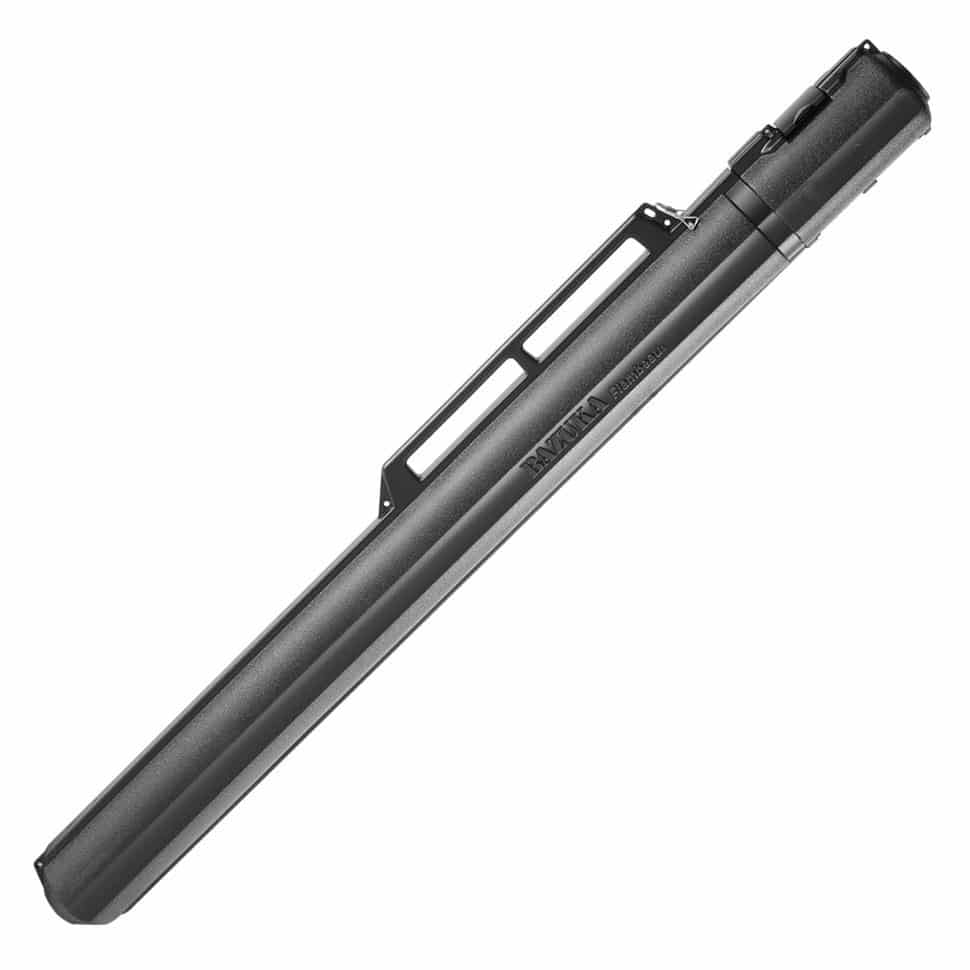
Flambeau’s contoured, blow-molded Bazuka rod tube is tough, built to stop the bends, crushes or breaks that destroy rods in a soft-sided bag. With a 3-inch diameter, and measuring anywhere from 63 to a telescoped 87 inches, the one-piece rod tube handles up to six 6-foot, 6-inch rods. The tube is padded at both ends to protect rod tips and rod butts. Airports can’t reject this type of luggage, as it meets all Transportation Security Administration (TSA) air travel requirements. The rod tube is lockable for extra security, and comes with a durable handle for easy handling.
Telescope for Success
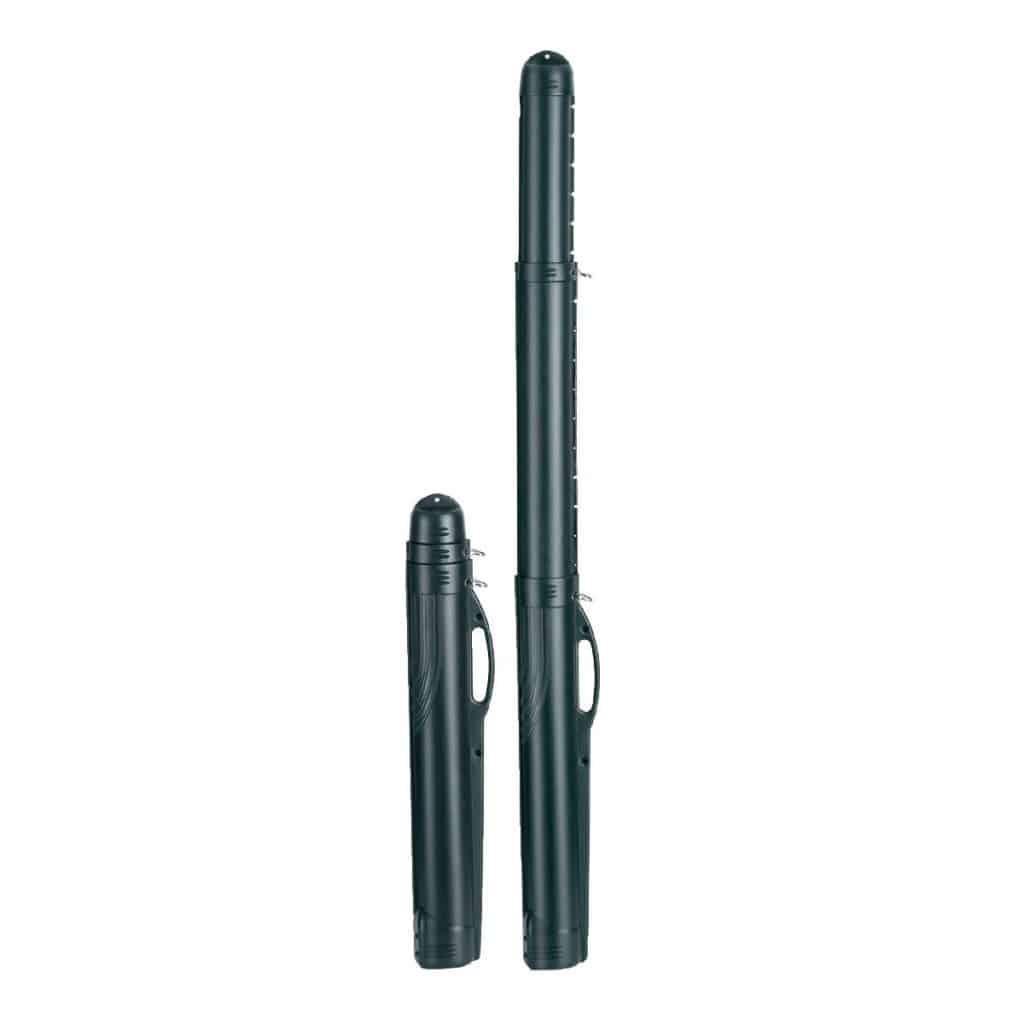
Plano’s 4.5-inch diameter Guide Series Airliner Telescoping Rod Tube features a three-tier design that collapses as small as 47 inches long or extends as long as 88 inches. At 44 inches, easily store it in a closet when not in use. Its smallest setting is still large enough for 3-piece spinning rods or 4-piece fly rods. At 88 inches, the rod tube handles up to eight 7-foot rods. A
convenient carry handle allows the rod tube be lugged around an airport easily. You won’t find many rod tubes that can handle more fishing rods than this one.
A Different Approach
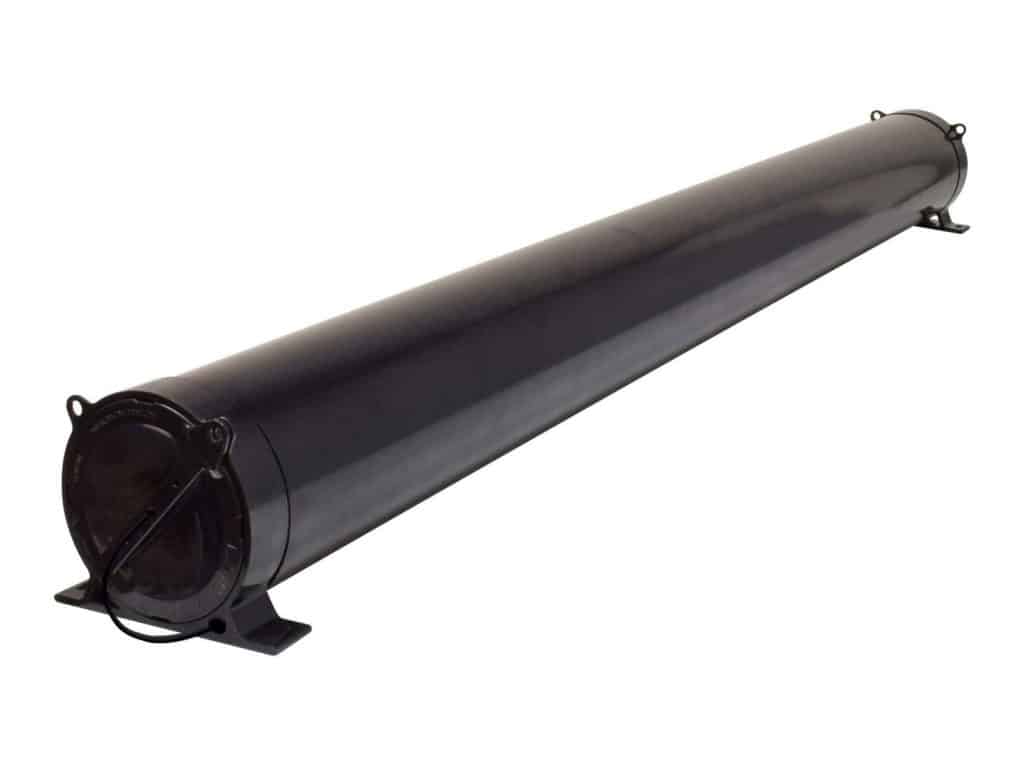
Sometimes a hard case built for a completely separate purpose is the perfect option for a rod case. The Valterra Black carrier’s intended purpose is for a hose, but measuring 50 up to 94 inches, and with a diameter of almost 5 inches, it’s a perfect option for fishing rods. The tube is easily adjustable, has hinged door caps with twist latch closures, and even spot for a padlock. What’s unique about this case is that it comes with a mounting bracket and screws to install to a roof rack with a little ingenuity. That keeps the rods out of the truck cabin and safely stored on the roof.
- More: Gear , Shop
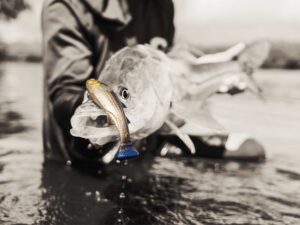
How to Catch More Fish Using Soft Plastics

NextMarine: The Future of Saltwater Angling
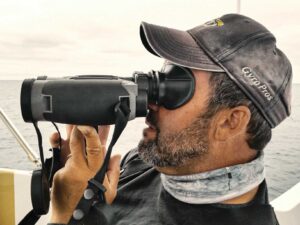
The Benefits of Gyrostabilized Binoculars

8 Top Soft-Sided Tackle Bags and Backpacks
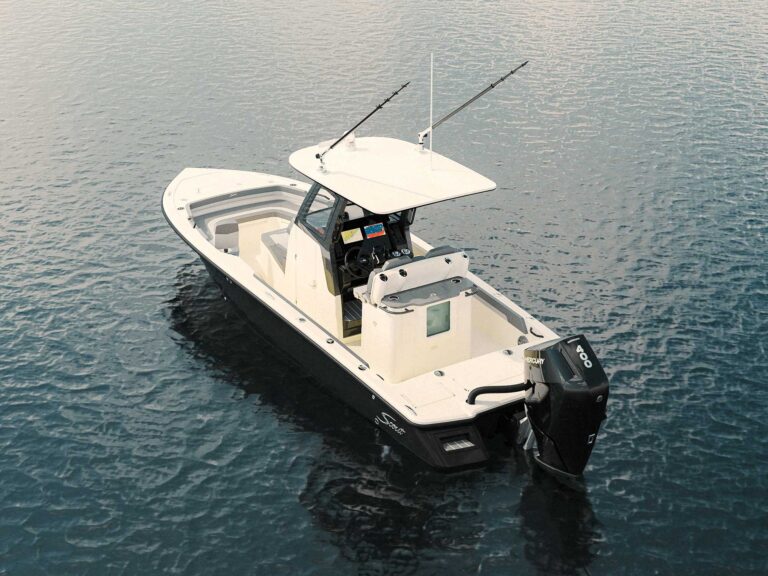
Scout 261 XSS

Wise Boaters Trust Sierra Parts

Cox 350 Diesel Outboard

- Digital Edition
- Customer Service
- Privacy Policy
- Cruising World
- Sailing World
- Salt Water Sportsman
- Sport Fishing
- Wakeboarding
Fishing Skillz
Fishing Skillz is reader-supported. When you buy through links on our site, we may earn an affiliate commission at no additional cost to you.
3 Tips For Traveling With Fishing Rods (FREE DIY Rod Tube Instructions)

Traveling With Fishing Rods (Plus DIY Rod Tube Instructions)
Traveling with a fishing rod is a reality for many anglers. Whether traveling for the sole purpose of fishing, dual-purpose vacation, or simply as a “just-in-case”; having a fishing rod along on your travels can be incredibly rewarding. However, the hassle some people think that comes with traveling with these oversized and fragile objects can often times be a deterrent.
It can be quite cheap and easy to travel, or even fly, with fishing rods and have the piece of mind that they are safe and sound inside.
Every day, thousands of fishing rods are shipped damage free all over the country. With shorter break-down rods, you can even avoid excess baggage fees by following our tricks below.
Whether it means transporting your one piece fly-rod on a road trip, flying with a stack of fishing rods to the remote Canadian tundra, backpacking into a remote mountain stream, or flying carry-on with a small rod tube; traveling with fishing rods is a reality.
Here are some great tips, tricks, and products that will make your life easier and keep your rod safe.
Types Of Fishing Rod Cases
1. rod tubes.
Rod tubes are typically the first association with heavy duty rod travel. After all, fishing rod tubes are the type of container fishing rods are shipped in from the manufacturer. From these cardboard shipping containers to more sophisticated rod tubes offering guaranteed protection, the natural geometric strength of a cylindrical design is hard to beat and has proven itself as a solid choice. Especially when on a budget.
2. Rod Cases
Rod Cases are a more feature packed option and can be associated with seriously rugged use. However, some rod cases on the lower end of the price spectrum may not be suitable for heavy duty travel.
Rod cases offer a more appealing way to store your rods than shoving them in a tube. Generally protected by heavy duty locking latches or zippers, these flip open cases are often capable of holding multiple rods and reels in an appealing display style fashion.

Buy on Amazon.com
For an attractive and protective cased to transport your rods in, check out this JEKOSEN 2019 Portable Travel Fishing Rod Reel Case review.
At a nice mid-range price, this zip open rod case will store sections of rod up to 5 feet in length and can hold up to 4 sections of rod.
On top of that, it features additional zipper storage on the lid and can likely fit a few more key items stuffed inside the case with a little padding.

Made from similar material to hard-shell suitcases, you can trust this case to protect its contents through rigorous travel. This is a simple no-frills rod case that will offer great protection in it’s slim and sleek design.
3. Roof Vaults
Roof Vaults are great for anglers fishing out of their vehicles. Particularly, fly-fishing anglers and surf casters with exceedingly long rods. Jumping around from spot to spot on the river or lake to lake gets much easier with these roof vault type cases.
For longer rods, roof vaults offer the quick and easy convenience/access of slide-in storage securely mounted to your roof. Most are generally equipped to store the fully rigged rod and reel which makes them so convenient.
They’re also a great tool for long road trips where you’re taking a fishing rod along as it frees up much needed room inside the cab or bed. These options, while a little pricier than others, can be the best and most convenient option for certain styles of fishing.
4. DIY Sewer Tube (And How To Make Your Own Fishing Rod Case)
For the frugal folks, the budget bums, people like me; here is the cheap way to safely store your rods. All it takes is a little work.
Starting off with a few simple components that should cost you around $20, you can have a durable and reliable rod tube for years to come. Fly it on a plane, strap in on a car, or make a small one for your break-down backcountry fishing rod setup.

-Purchase either traditional PVC pipe or lighter weight triple-wall sewer drain pipe from your local hardware store (I prefer the latter). This should cost you somewhere around $10.
-For sizing, I like 3 inch or 4 inch pipe.
-Next, find some properly sized fittings for the ends. You will need a glue-on cap on one end and a screw on cap for the other. Lastly, you will need a can of two in one PVC glue. You want the one with both the primer and the actual glue. (It always helps to buy the pipes and fittings in person to verify the size pipe you want and make sure the fittings are the proper size.)

Glued on end-cap
-Once you have all your components, cut your pipe to the length you desire with a hacksaw or other tool.
-Liberally apply PVC glue to your pipe and cap both and then glue your end cap securely on one end.
-Now glue your screw on cap on the other, let it set, and you have a rod case.

For extra protection, you can always ad a piece of foam to your glue-on cap or slide it in after the fact to protect from rod tip damage. You can also paint the case as you wish and when traveling with it, it’s always a good idea to have your name and contact info somewhere on the case written in permanent marker.
How To Travel With A Fishing Rod (Expert Tips and Tricks)
Flying with fishing rods.
Flying can be the most rigorous type of travel on fishing rods. Worse yet, your precious cargo is out of your sight for most of it. As such, most people ensure they have a heavy duty case for checking their fishing poles as baggage.
When flying, you’re certainly going to want to use a hard case for your rods. Whether you go with a rod case, rod tube, or make your own out of pvc, it’s much more a personal choice in what you feel comfortable with.
Just make sure you pack your rod with plenty of padding and write your name and address permanently somewhere on your case.
Looking for a case for a flight coming up quickly? Check out the JEKOSEN 2019 Portable Travel Fishing Rod Reel Case .
Expert Tip:
Carry-on baggage can save you fees if you can somehow manage to pack all your belongings in it. One of which, can be a 4 piece break-down fishing pole or fly-rod that you can slide into your carry on bag or personal item. Save on fees and trust your fishing gear is in good hands.
Driving With Fishing Rods
Driving with your rod puts you in control of the handling. You can go with absolutely no protection or a full blown rod case when driving. Regardless, it is always nice to have your rod in some form of hard protection to avoid any accidents. If you are simply doing long distance travel to a fishing destination, any type of rod case or rod tube will offer more than ample protection. You can likely even strap it to the roof of your car.Alternatively, if you are hoping from fishing hole to fishing hole in your car and want quick and easy access, consider something like a rod vault. These full protection tubes mount on the roof of your car and generally have room for a fully rigged rod/reel setup. These are often favored by fly fishing anglers who carry long cumbersome rods between shuttle points on rivers or fishing holes.
You can also use a clamping style ski rack or snowboard rack that mounts to your roof to hold your fishing rods.
Hiking With Fishing Rods
Hiking to access fishing spots can sometimes be the best way to get your lures or flies in front of wild and willing fish. When covering miles overland or backpacking in somewhere, you probably don’t want your rod in hand the whole time.
A small lightweight rod tube is generally the way to go for this type of transport to strap on to your pack. Also, for fly rods especially, a 4-piece take-down style is really the ticket for this type of travel.
Utilizing a small homemade pvc tube as seen above (maybe try 2 inch pipe) or a sleek and lightweight rod tube like this MaxCatch Carbon Fiber Rod Tube .
Slide your reel into an old sock or beanie to protect it in your backpack while hiking.
Final Thoughts
If you need to travel with your fishing rods, there’s no reason you can’t do so, especially with some of the tips and ideas we shared in this post.
If you’re on a tight budget, then consider making your own fishing rod tube. It’s inexpensive and very simple to make. You can read through the instructions again by following this link: DIY Fishing Tube Instructions.
But if you want something that looks a little nicer, then consider picking up the JEKOSEN 2019 Portable Travel Fishing Rod Reel Case or the MaxCatch Carbon Fiber Rod Tube .
You’ll enjoy travelling a whole lot more knowing your fishing rods are safe and will be ready to toss a line in the water at your next destination.

Written by Don
When I'm not bass fishing or looking for steelhead in my home state of Oregon I can be found working on house projects dreaming of my next fishing adventure.
I started this website to share just some of the things I've learned along my fishing journey, and the many things I'm still learning. Enjoy!

What Battery To Use For A Fish Finder (3 Best Fish Finder Batteries)

Lake Trout vs Rainbow Trout (Similarities and Differences)
© 2024 by Fishing Skillz

Pine Knoll Lodge & Cabins
Diy Fishing Rod Travel Case
A fishing rod travel case is a must-have for any angler who loves to fish on the go. While there are many commercially available cases on the market, you can also easily make your own case at home. This article will show you how to make a DIY fishing rod travel case that is perfect for your needs.
The first step is to choose the materials you will need for your case. You will need a sturdy box or container, some foam insulation, and a cutting tool. The size of your box will depend on the size of your fishing rod. You will also need to decide on the shape of your case. A simple rectangular or square box will work, but you can also get creative with a more custom shape.
Once you have chosen the materials, it is time to start cutting. The foam insulation should be cut to fit snugly around the fishing rod. Make sure to leave enough room for the rod to fit comfortably in the case. If you are using a custom shape for your case, you will also need to cut the foam to fit.
Once the foam is cut to size, it is time to assemble the case. Start by placing the fishing rod in the box or container. If you are using a rectangular or square box, you can then place the foam insulation in the box around the rod. If you are using a custom shape, you will need to place the foam in the correct position before closing the case.
Once the foam is in place, close the case and secure it with tape or a closure. You now have a custom fishing rod travel case that is perfect for your needs.
- 1 How do you make a travel rod tube?
- 2 How do you make a simple fishing rod holder?
- 3 How do you travel with a fishing rod on a car?
- 4 How do you make a PVC fishing rod holder?
- 5 How do I make a homemade rod tube?
- 6 How do you make a PVC rod tube?
- 7 How do you make a homemade rod holder?
How do you make a travel rod tube?
Making a travel rod tube is a great way to protect your fishing rods while on the go. There are many different ways to make a travel rod tube, but the following is one of the simplest and most effective methods.
To make a travel rod tube, you will need:
-A PVC pipe
-A measuring tape
1. Measure the length of your PVC pipe and mark it with a marker.
2. Cut the PVC pipe with a hacksaw.
3. Drill a hole in each end of the PVC pipe.
4. Cut a piece of fabric that is slightly larger than the PVC pipe.
5. Sew the fabric around the PVC pipe.
6. Sand the edges of the fabric to prevent them from fraying.
7. Insert your fishing rods into the PVC pipe.
8. Close the fabric around the fishing rods with a zip tie.
Your travel rod tube is now ready to use!
How do you make a simple fishing rod holder?
There are a few different ways that you can make a fishing rod holder. In this article, we will show you how to make a simple fishing rod holder using a PVC pipe and some clamps.
To make this fishing rod holder, you will need the following supplies:
-Tape measure
– hacksaw
-Pipe cutter
-Paint or a sealant
The first thing you need to do is measure the PVC pipe to fit your fishing rods. You will want to make sure that the PVC pipe is at least as long as the fishing rods.
Once you have measured the PVC pipe, use a hacksaw to cut the pipe to the desired length. If you are not comfortable using a hacksaw, you can also use a pipe cutter to cut the pipe.
Once the PVC pipe is cut to the desired length, use a pipe cutter or a hacksaw to cut the pipe into two pieces. The two pieces should be the same length.
Next, use a clamp to attach the two pieces of PVC pipe together. Make sure that the clamps are tight, so that the PVC pipe does not move.
Once the PVC pipe is clamped together, use a tape measure to measure the width of the fishing rods.
Next, use a hacksaw to cut a piece of PVC pipe to the desired width. This piece of PVC pipe will be used to hold the fishing rods.
Once the PVC pipe is cut to the desired width, use a pipe cutter or a hacksaw to cut the pipe into two pieces. The two pieces should be the same width.
Next, use a clamp to attach the piece of PVC pipe to the top of the PVC pipe. Make sure that the clamps are tight, so that the PVC pipe does not move.
Now, your fishing rod holder is finished! You can use this holder to store your fishing rods while you are not using them. You can also use this holder to take your fishing rods with you on your next fishing trip.
How do you travel with a fishing rod on a car?
When you’re traveling with a fishing rod, you want to make sure that it’s well-protected. There are a few ways to do this. One way is to put the fishing rod in a protective case. This will protect it from getting damaged. Another way to protect the fishing rod is to put it in the car’s trunk. This will protect it from the wind and the sun.
How do you make a PVC fishing rod holder?
Making your own PVC fishing rod holder is a great way to save money and have a custom holder that is exactly the size you need. There are a few different ways to make a PVC fishing rod holder, but all of them involve cutting and drilling PVC pipe.
The simplest way to make a PVC fishing rod holder is to cut two pieces of pipe to the desired length and then drill a hole in each one for the fishing rod to fit through. If you want to make a more secure holder, you can also add a PVC fitting to the top and bottom of the holder. This will allow you to attach the holder to a post or a wall.
If you want to make a fishing rod holder that can be used in the water, you can add a PVC fitting to the top and bottom of the holder and then attach a piece of PVC pipe to each fitting. This will create a holder that is stable in the water and that will keep your fishing rods from getting wet.
No matter how you choose to make your PVC fishing rod holder, it is important to make sure that the holder is stable and that the fishing rods fit securely in the holder.
How do I make a homemade rod tube?
A rod tube is a common piece of fishing gear that is used to protect fishing rods while they are not in use. It can also be used to protect the rod while it is in transit. There are a few different ways to make a homemade rod tube.
One way to make a homemade rod tube is to use a PVC pipe. You will need a PVC pipe that is at least as long as your fishing rod is. The PVC pipe should also be at least as thick as your fishing rod. You will also need a PVC pipe cutter to cut the PVC pipe to the correct length.
Once you have the PVC pipe, you will need to cut one end of the pipe off. This will be the end that you will put your fishing rod in. The other end of the PVC pipe will need to be sealed. You can do this by using a PVC glue or a PVC sealant.
Once the PVC pipe is sealed, you can put your fishing rod in the tube. You can then use the PVC pipe to protect your fishing rod while it is not in use or while it is in transit.
Another way to make a homemade rod tube is to use a cardboard tube. You will need a cardboard tube that is at least as long as your fishing rod is. The cardboard tube should also be at least as thick as your fishing rod.
Once you have the cardboard tube, you will need to cut one end of the tube off. This will be the end that you will put your fishing rod in. The other end of the cardboard tube will need to be sealed. You can do this by using tape or a hot glue gun.
Once the cardboard tube is sealed, you can put your fishing rod in the tube. You can then use the cardboard tube to protect your fishing rod while it is not in use or while it is in transit.
How do you make a PVC rod tube?
Making your own PVC rod tube is a great way to protect your fishing rods while they are not in use. This project is simple and can be completed in just a few steps.
To make a PVC rod tube, you will need the following supplies:
-a piece of PVC pipe, at least 2 inches in diameter
-a PVC pipe cutter or a hacksaw
-a measuring tape
1. Measure the length of your fishing rods and cut the PVC pipe to that length.
2. Use a marker to draw a line around the PVC pipe at the desired height of your tube.
3. Use a hacksaw or PVC pipe cutter to cut the pipe along the line.
4. Measure and mark the desired width of your tube.
5. Use a hacksaw or PVC pipe cutter to cut the pipe to the desired width.
6. Use a level to make sure the tube is straight.
7. Use a measuring tape to measure the inside diameter of the tube.
8. Cut a piece of PVC pipe to the desired length and inside diameter.
9. Slide the cut piece of PVC pipe into the tube.
10. Use a level to make sure the piece of PVC pipe is straight.
11. Use a hacksaw or PVC pipe cutter to cut the piece of PVC pipe to the desired length.
12. Slide the cut piece of PVC pipe into the tube.
13. Your PVC rod tube is now complete!
How do you make a homemade rod holder?
Making a homemade rod holder is a great way to save money and customize your fishing gear. There are a few different ways to make a rod holder, so choose the method that best suits your needs.
One way to make a rod holder is to use a PVC pipe. Cut the PVC pipe to the desired length, and then use a saw to cut a V-shape into one end. The V-shape will hold the rod in place. You can then use a hot glue gun to attach a PVC T-joint to the other end of the pipe. The T-joint will allow you to attach the pipe to a post or a railing.
Another way to make a rod holder is to use a piece of lumber. Cut the lumber to the desired length, and then use a saw to cut a U-shape into one end. The U-shape will hold the rod in place. You can then use a screwdriver to attach a wooden T-joint to the other end of the lumber. The T-joint will allow you to attach the lumber to a post or a railing.
Finally, you can also make a rod holder using a metal pipe. Cut the metal pipe to the desired length, and then use a saw to cut a V-shape into one end. The V-shape will hold the rod in place. You can then use a drill to attach a metal T-joint to the other end of the pipe. The T-joint will allow you to attach the pipe to a post or a railing.
No matter what method you choose, make sure that the rod holder is secure and will not fall over. You can also add a cushion or a pad to the holder to protect the rod. Enjoy your new homemade rod holder!
Related Posts
Good travel snacks for diabetics, good time to travel to cancun.
Search for: -->
Best fly rod case – ultimate buyer’s guide.
Last updated on March 5th, 2024.
- Recent Posts
- Fly Fishing Gear Essentials: What You Need to Start - April 18, 2024
- Catching the Calm: Psychological Benefits of Fly Fishing - April 17, 2024
- YETI Sidekick Dry 3L Review: Sweetspot Sizing - April 17, 2024
Fly rods are delicate and can break easily, particularly when travelling. Fly rod cases or travel cases protect your valuable gear.
It’s never a bad idea to splurge on something that is guaranteed worth the money—and the same goes for anglers who always want the best for their fishing experience. That said, if there is one thing you should invest in when protecting your equipment, it’s a fly rod case. Fly rods, for starters, are unarguably expensive but can be fragile, so they must be protected when you are always on the move to prevent damage.
Like any other fishing gear, fly rod cases come in different styles, sizes, and materials. They can be hard or soft-sided; some variations even come with wheels for easy transport. A good fly rod travel case will protect your rod from scratches and dings and prevent it from getting tangled with other gear during travel . When choosing a fly rod case , it’s essential to be mindful of the size and weight of your rod and the type of travel you’ll be doing. If you often go from one place to another by plane , you’ll want a sturdy case to withstand the rigors of airline travel. If you’re hiking to a remote fishing spot, you’ll want a case that’s lightweight and easy to carry. Whatever your needs, investing in a quality fly fishing rod case is a wise decision that will protect your gear and ensure you can enjoy your fishing adventures for years.
Table of Contents:
Review of the Best Fly Rod Travel Cases
Hard Fishing Rod Case vs. Soft Fishing Rod Case
Why a fly rod travel case is worth the investment, important features of fly rod cases.
Best Fly Rod Cases – Editor Picks
Patagonia Black Hole Rod Case
Ll bean maine guide waxed rod case, sage ballistic rod and reel brief, simms gts rod and reel vault, fishpond dakota carry-on rod and reel case.
- Redington Rod Travel Cases – Double
Allen Company Cottonwood Fly Fishing Rod & Gear Bag Case
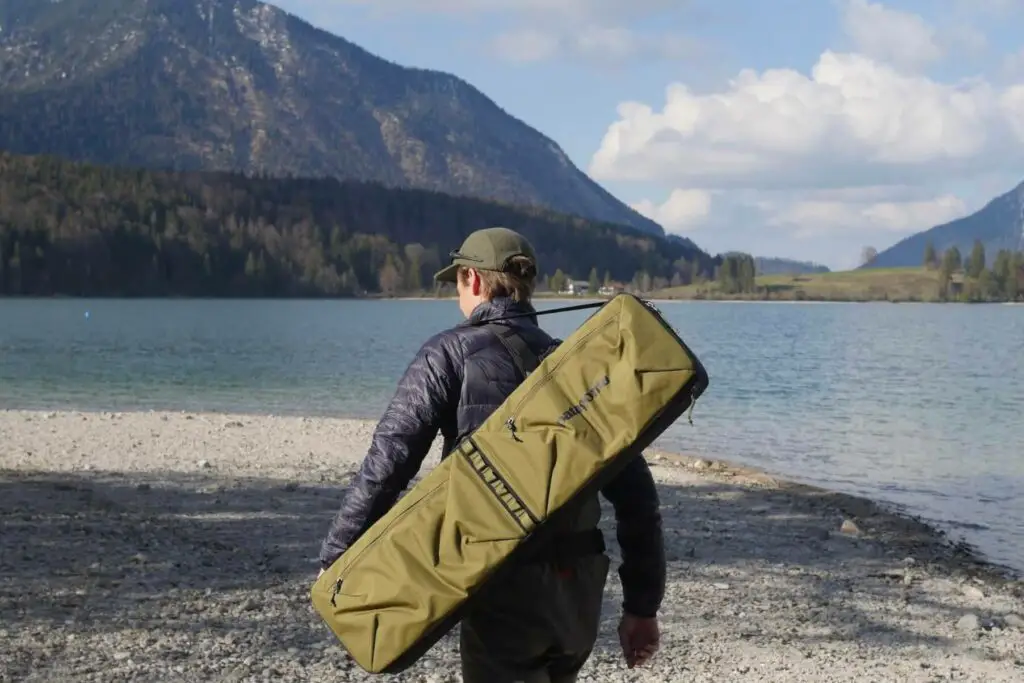
Review of the Best Fly Rod Cases In 2023
Disclaimer: All products in this guide are independently researched by our team. We only recommend products we believe in and never get paid for the reviews. Learn more about our review process here .
When it comes to fly fishing, a quality fly rod is an essential tool for any angler. But a good case is just as important to keep your fly rod safe and protected during transport or storage. With so many options available, choosing the right fly rod case can be a daunting task—but best believe that you will get your money’s worth, one way or another.
Whether you are a seasoned angler or a beginner, here are some of the best fly rod cases on the market for you to check out and choose from:
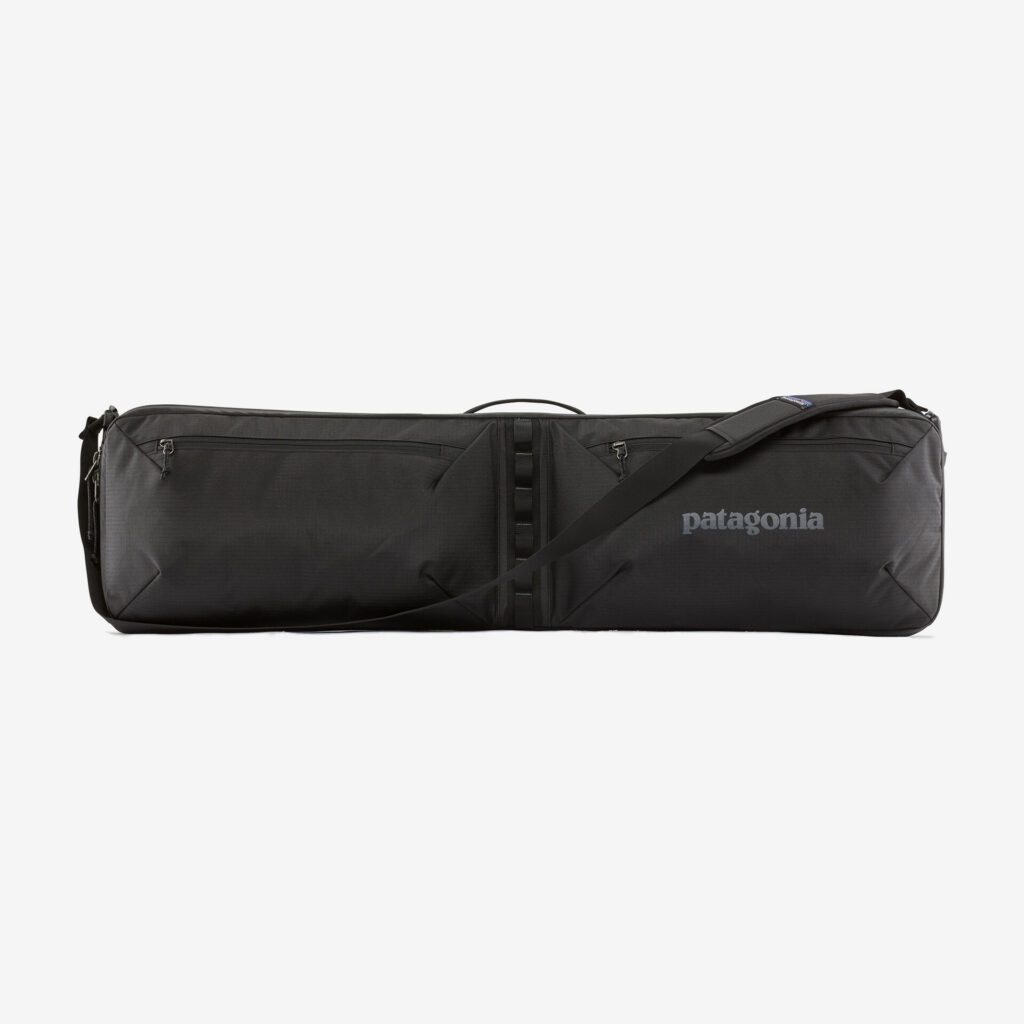
Key Features:
Available in two colors
- Made from 100% recycled material
Size (internal): 36″
Inside compartments are customizable
Adjustable shoulder strap
- Multiple attachment options
Why we picked it : Made from tough 300-denier post-consumer recycled polyester fabric with a recycled TPU laminate, the Patagonia Black Hole® Rod Case ( read our in-depth review here ) is built to withstand years of travel and outdoor use. With an internal length of 36″ and the ability to fit four-piece rods up to 11′, this case offers plenty of space to store your valuable fishing equipment. The modular internal storage dividers and two external pockets allow for customizable organization inside and out. The adjustable shoulder strap and grab handle make it easy to carry and move through airports. The multiple exterior clipping and lash-down points also ensure that your rod stays secure during the roughest of travels (remember however that the Patagonia Black Hole® Rod Case is not a hard case).
Out of the box, I’m a big fan of the Patagonia Black Hole® Rod Case. The only real drawback I could find is the fact that this fly rod case is quite heavy, weighing in at 2,637 g (5 lbs 13 oz). This may make it a bit heavy for some anglers looking for a more lightweight and compact option. Additionally, the price point may be a bit high for some budgets. However, this is an excellent choice if you prioritize durability and organization and are willing to invest in a high-quality product.
- Customisable inside compartments
- Quite heavy considering that it’s not a hardcase
GET IT AT PATAGONIA
GET IT AT VAIL VALLEY ANGLERS
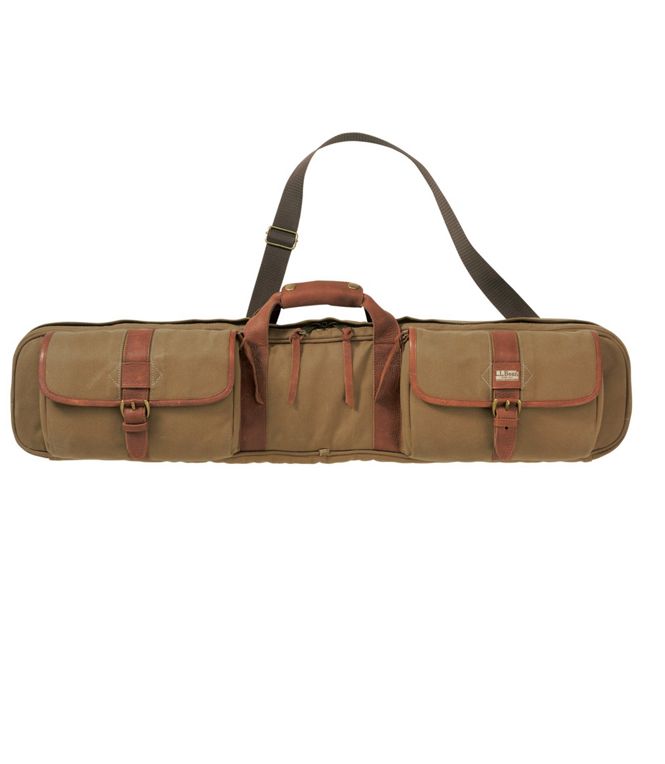
Four-piece rod case for transporting fishing rods
Made from durable, water-resistant waxed canvas material
Lined with soft flannel to protect rods from scratches
Accommodates up to three four-piece fly rod tubes
Features a zippered main compartment for easy access
Includes an adjustable, detachable shoulder strap for comfortable carrying
Measures 33 1/4″ L x 8 1/2″ W x 2 1/2″ D when closed
Why we picked it : If you want a rugged classic look, then consider the L.L.Bean Maine Guide ( read our hands-on review here ). This case is made from traditional waxed cotton canvas and is designed to withstand rough handling and outdoor use. This 4-piece fishing rod case can accommodate up to three four-piece rod tubes, providing ample space for your fishing gear. The quilted, padded lining also helps protect your gear from bumps and scratches. In contrast, the padded exterior pockets with zip closures and protective flaps offer additional storage for reels and fly boxes . The leather/fabric handles and removable shoulder strap make it easy to carry, and the spot-clean fabric and care instructions make maintenance a breeze.
One drawback of the L.L.Bean Maine Guide is the lack of modular internal storage dividers, which may make it difficult to organize your gear, particularly if you have many small items to store. However, the LL Bean Maine Guide Waxed Rod Case is a safe option if you prioritize style and a classic look.
- Classic canvas look
- Spacious outside pockets
- Rugged cloth
- Safe protection of rods only ensured when using the rod tubes
GET IT AT L.L.BEAN
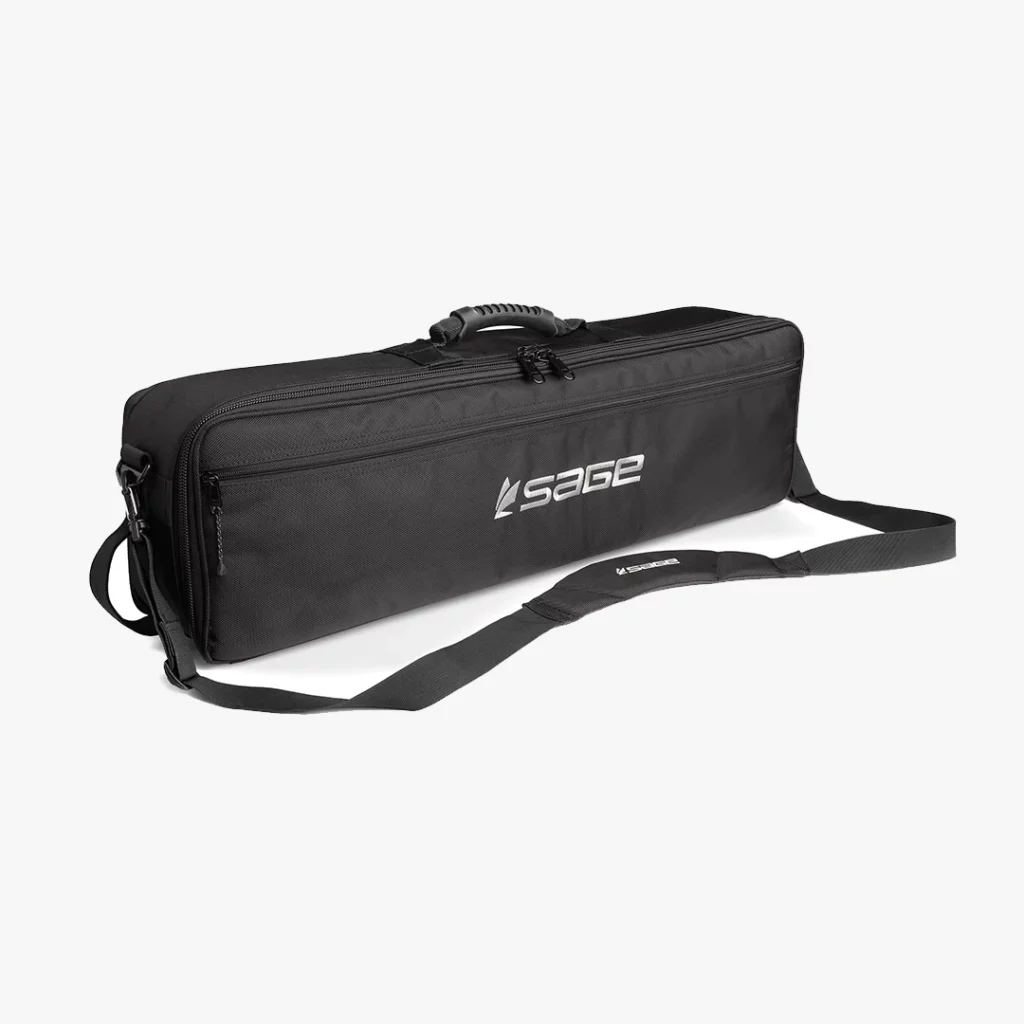
All black design
Size: 32″ x 9″ x 5″
9 customizable inside compartments
Lockable security zipper
Why we picked it : One of the most excellent options for anglers who prioritize organization and protection when traveling with their gear is the Sage BALLISTIC ROD & REEL BRIEF. This briefcase-style case is made from durable ballistic nylon and is designed to keep your rods , reels , lines , tippet , tools , and more organized and secure during travel. The case features impact-resistant top, bottom, and side panels and nine internal, adjustable, and removable padded dividers for reels, and three internal mesh pockets for more organized storage and quick access to essential items.
The Sage BALLISTIC ROD & REEL BRIEF also includes an exterior zippered storage pocket, a detachable, adjustable shoulder strap with a flexible gripping pad for comfort, and a rubber-to-webbing easy-grip handle for easy carrying. Whether you’re embarking on a travel adventure or simply need a daily organizer for your gear, this case is a reliable choice. I like the fact that this bag can store a lot of tackle when travelling, hence you can make sure to have everything in one place and won’t forget any important gear.
- Security zipper is great for air travel
Customisable on the inside
- Holds a lot gear
- Shoulder strap could use an upgrade in terms of padding
GET IT ON AMAZON
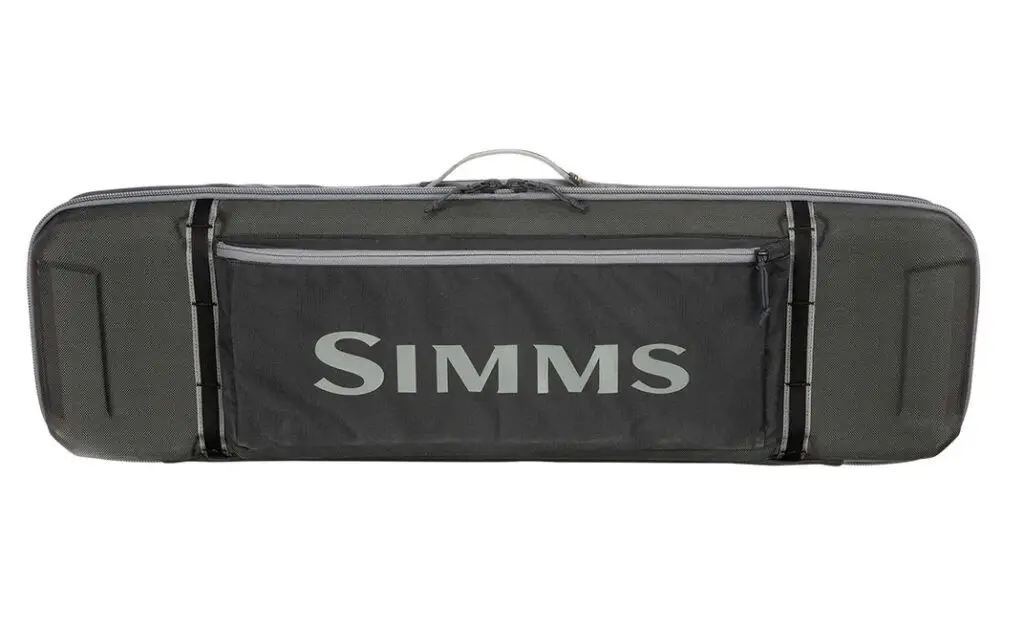
One size, one color
Made from ballistic nylon
Size: 32.5″ x 9″ x 6″
Max capacity: six 9’6″ four piece rods
Can be attached to Simms’ rolling GTS duffel
Why we picked it : The Simms GTS Rod and Reel Vault is also one to look out for when choosing the most suitable case for your angling needs. The compression-molded ballistic nylon and 200D polyester lining offer superior protection against crushing, weather, and other forms of damage that can occur during travel. The clamshell zippered opening to the main compartment, zippered face pocket, and mesh pockets in the lid provides ample storage space for up to six 9’6” 4-piece rods and eight reels/spools (that’s a lot of gear for one trip, even if you’re a die hard fly fisherman). The internal straps and dividers keep everything secure and organized during transport, while the reinforced daisy chains and webbing loop offer additional lashing and attachment options to other luggage.
The outer shell of the Simms GTS Rod and Reel Vault is made of 1680D Polyester Ballistic, which is resistant to wear and tear, while the face pocket is made of 420/660D CORDURA ripstop with double-sided PU coating for added protection. The lining is 200D polyester with foam padding to cushion your gear from impact. However, its accessories are sold separately, so you may need to purchase additional dividers or straps if you have more gear to pack.
- Made from highly durable ballistic nylon
- Fits 6 rods and 8 reels
- This is not the right choice if you’re looking for a compact travel rod case
GET IT AT TRIDENT
GET IT THE RIVER’S EDGE
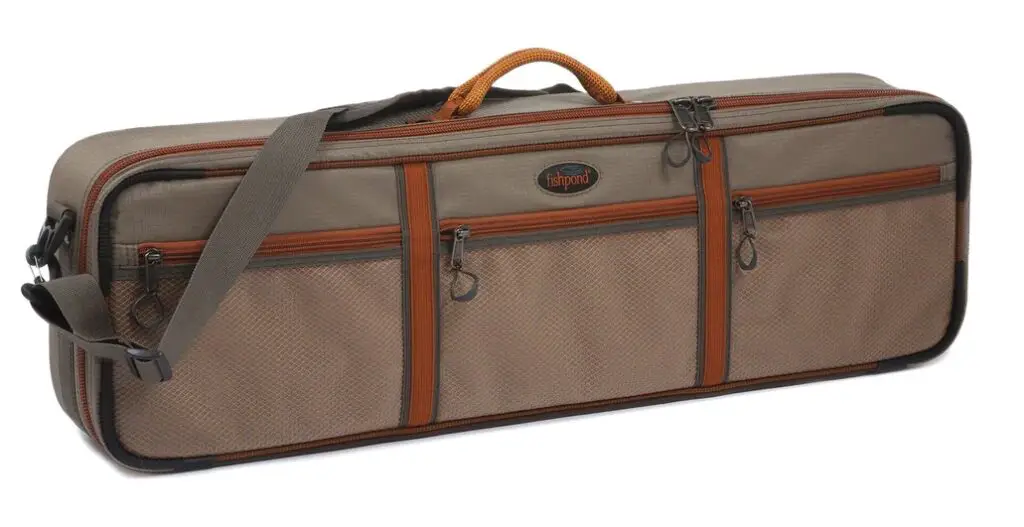
Waterproof bottom
Transparent exterior mesh pockets
Size (internal): 30″ x 8.5″ x 3.5″
Made for 9′ four piece rods
Weight: 5.2 lbs
Why we picked it : With adjustable, padded, and removable interior dividers, the sturdy Fishpond Dakota Carry-on Rod and Reel Case ( read our in-depth review here ) provides ample space for reels and other accessories while protecting them from harm. The big padded compartment with a protective lid can hold up to four rods in their socks, depending on their length. Moreover, the three mesh interior pockets and three laminated see-through exterior mesh pockets offer additional storage options for essentials like keys, phones, and airline tickets. This is a really handy feature in my eyes that makes the Fishpond Dakota Carry-on Rod and Reel Case stand out from the rest of the fly rod cases. No need to open any pockets and risk something falling out – a great feature!
What sets this case apart is its commitment to sustainability. Fishpond uses repurposed nylon in their fishing nets, recycled fly boxes, and NewStream fabric made from 100% recycled water bottles. This approach aligns with their guiding mantra of sustainability, and they are constantly striving to create new gear without using new materials. With its high-quality design, ample storage options, and commitment to sustainability, the Fishpond Dakota Carry-on Rod and Reel Case is a great choice for those looking for a reliable and environmentally-friendly option.
- Transparent outer mesh pockets
- Big inside mesh pocket for easy overview
- Just like the Patagonia, the Fishpond is on the heavier side for a “soft” travel bag
GET IT AT BACKCOUNTRY
Redington Fly Rod Travel Case
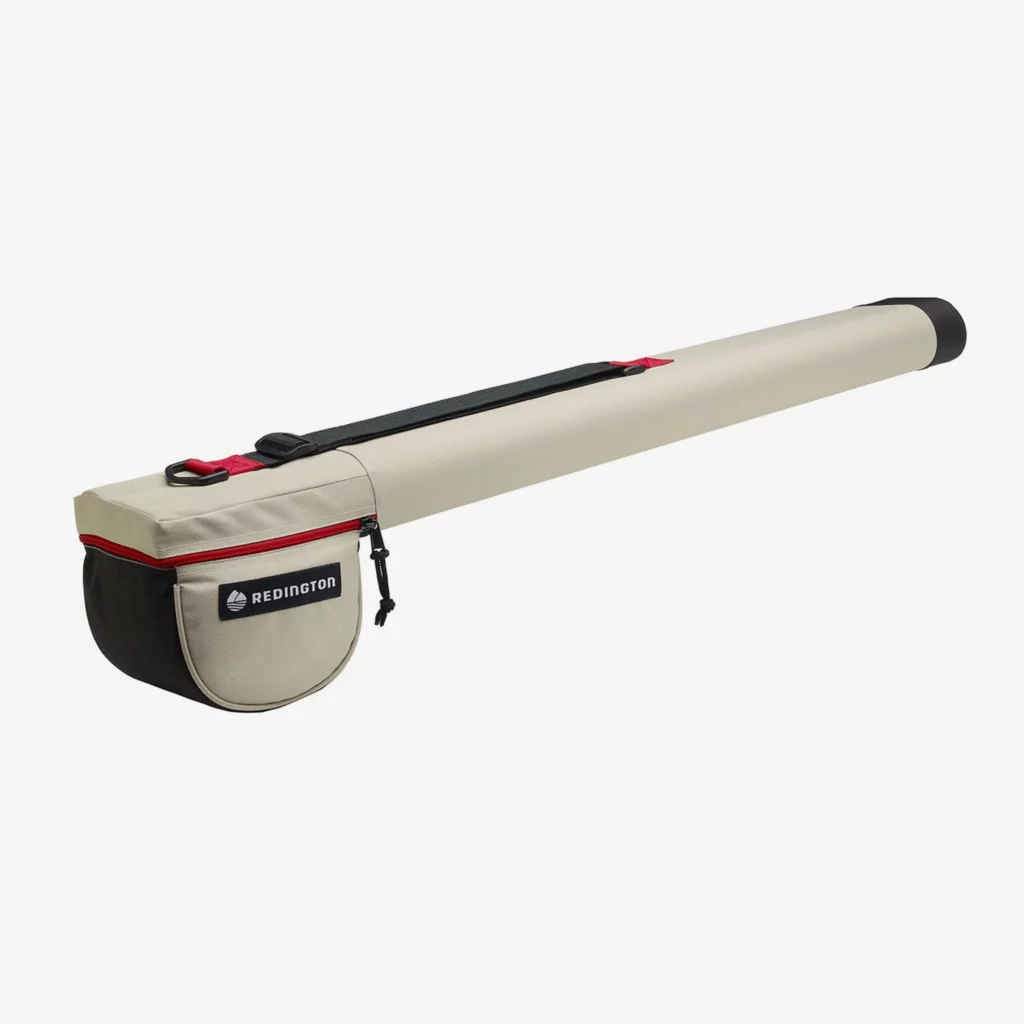
Available in different lengths and as single or double
Reenforced caps
9′ and 10′ rod options and 2 pcs and 4 pcs options
D-ring for easy hanging storage
Why we picked it : The Redington Fly Rod Travel are available in double rod configurations for 9′ and 10′ rods and are designed to hold both 2-piece and 4-piece rods and reels. The cases are made with a YKK zipper and plastic-reinforced caps at the ends to ensure the case can withstand rough handling during travel. Additionally, the adjustable shoulder strap and D-ring make it easy to carry or hang the case when not in use. The 9′ 2-piece case is 58″ long, while the 9′ 4-piece and 10′ 4-piece cases are 31″ and 34″ long, respectively.
If you’re looking for something that provides great price value, consider the Redington Fly Rod Travel. They offer ample protection for your gear during transport and have convenient features like the adjustable shoulder strap and D-ring for hanging. Plus, a fact that I personally like, when you want to safe time, is the fact that you can leave your reel attached to your fly rod when picking the Redington Fly Rod Travel Case.
- Reenforced caps for extra protection
- Great variety in sizing options
- The color makes the case get a little dirty quite easily
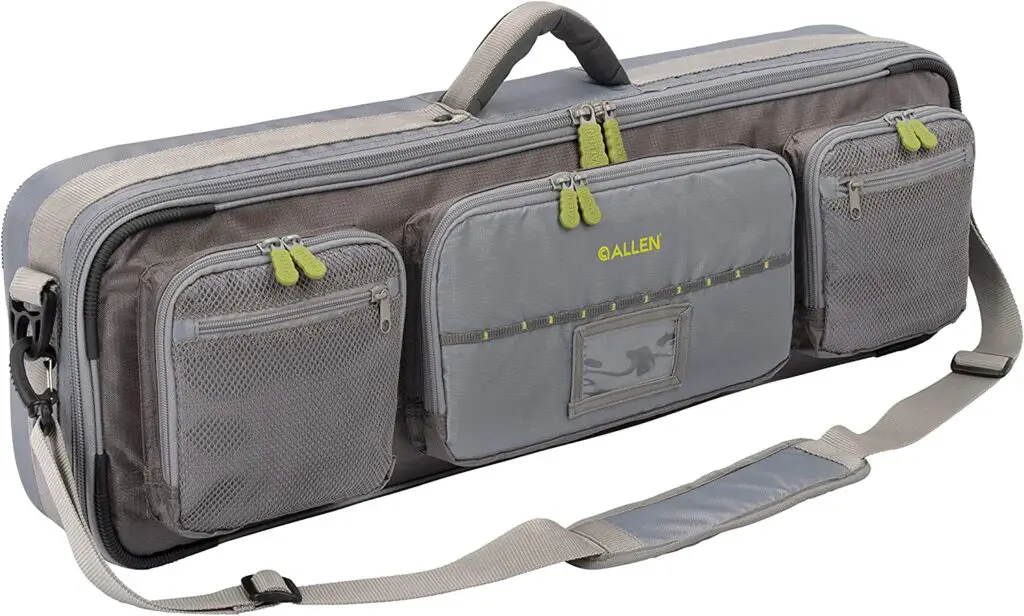
Dimensions: 32″ x 10″ x 6″
Padded shoulder strap
Why we picked it : The Allen Company Cottonwood Fly Fishing Rod & Gear Bag Case can fit 4-piece, 9.5-foot long fishing rods. The internal main compartment is customizable with Velcro pockets to fit all your gear comfortably. The lightweight design makes it easy to carry, and the padded adjustable shoulder strap ensures your comfort. The case has multiple interior see-through zippered storage pockets to organize and easily identify your accessories. Additionally, the bottom D-ring allows you to attach your tippet spool holder and other accessories for convenience. The padded exterior storage pockets and non-slip, wear-resistant bottom provide extra protection for your gear.
If you want something that’s easily customizable and easy to carry, the Allen Company Cottonwood Fly Fishing Rod & Gear Bag Case is a great case to consider—whether you’re a beginner or an experienced angler. In terms of dimensions and build, I found it to be very similar to the Fishpond or Patagonia, although it features zippered pockets on the outside which allow for easy access – a neat feature.
- Outside pockets with zippers for quick access
- Transparent ID pocket
- Shoulder strap was a weakness in the test when the bag was fully loaded
GET IT AT ALLEN
When it comes to protecting your fishing rods during transport, there are two variations that you can choose from: hard cases and soft cases . Hard cases are typically made of plastic, aluminum, or other sturdy materials. Soft cases, on the other hand, are made of fabric, such as nylon or polyester canvas. Naturally, there are pros and cons to both types of cases, and the best option for you will still depend on your specific needs.
Hard Fishing Rod Cases
One advantage of hard fishing rod cases is that they provide superior protection for your rods . Hard cases are more durable and sturdy than soft ones, so they can better protect your rods from damage during transport. This is particularly important if you’re traveling by air or transporting your rods in a crowded vehicle where there is a big tendency that they would get bumped around.
Soft Fishing Rod Cases
Soft fishing rod cases are typically more lightweight and easier to carry than hard cases . That said, they are also often less harmful to your wallets than hard cases, making them a good option for anglers on a budget. They also tend to be more flexible, allowing you to pack more gear compared to what you can squeeze in a hard case. This is an advantage when traveling to a remote fishing location and needing to pack a lot of gear without wanting to carry extra bags.
Choosing between a hard fishing rod case and a soft one will depend on your specific needs and preferences. A hard case is probably the better choice if you’re looking for guaranteed protection for your fishing rods. But a soft case is an excellent option if you want something lightweight, easy to carry, and won’t break the bank.
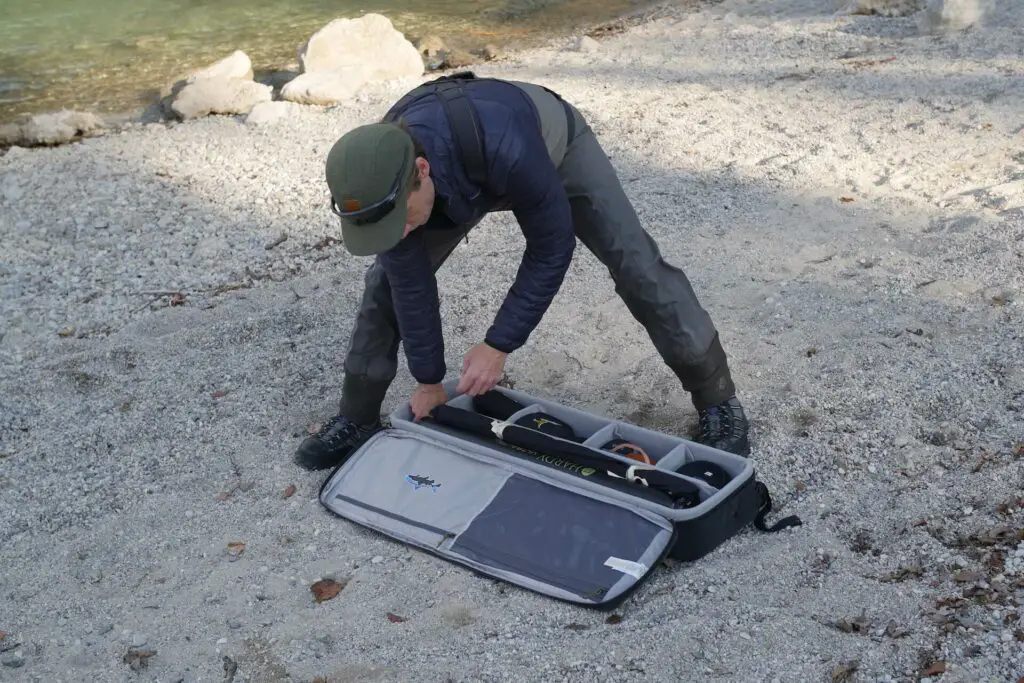
Any angler must protect their gear during travel to avoid damage or breakage. A quality fly rod case is a critical investment that protects the fly rod from scratches, dents, and other damage during transportation. Without one, a fly rod is vulnerable to damage caused by rough handling, bumps, or even water exposure.
When choosing the right fly fishing rod case, anglers must carefully consider the features that meet their needs. For instance, some cases are designed for specific rod lengths, while others are adjustable and can accommodate multiple sizes.
Simply put, a quality fly rod case is essential for anglers who want to protect their valuable gear during travel. By carefully considering the features and selecting a case that suits their typical transportation and fishing situation, anglers can have peace of mind knowing that their fly rods are safe and secure during transport. Here are some things to consider when choosing the most suitable case for your angling needs:
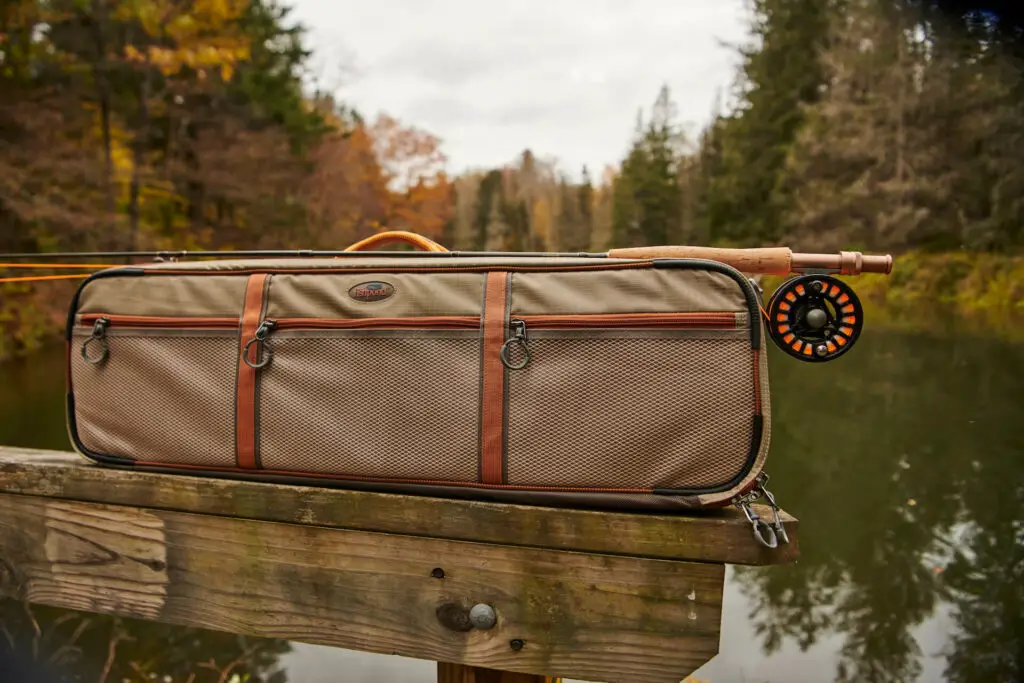
To ensure maximum usage, the size of your case should be at least the length of the longest fly rod you need to store inside, and it should also have enough room for the reel to be attached to the rod . However, be careful in putting a rod too short for your case because it would be moved around too much inside when transporting.
You must also be wary of choosing a case that’s too short, as it may damage your rod’s tip. In such cases wherein a fly rod case allows you to put multiple fly rods , try to choose a case that’s large enough to accommodate all your fly rods, but should not be too bulky to carry around when you are on the move.
When it comes to material, fabric, and nylon cases are lighter, more flexible, easier to carry around, and generally more affordable than hard plastic ones However, hard plastic fly rod cases are more durable and provide better protection against harsh weather conditions, impacts, and scratches. They are ideal for frequent anglers who must protect their fly rods from damage during transport.
Hard plastic cases are typically more expensive than fabric and nylon cases , but they offer more peace of mind knowing that the fly rods are safe and secure. They may also sometimes come with foam padding, which helps to absorb shock and protect the fly rods from damage.
Portability
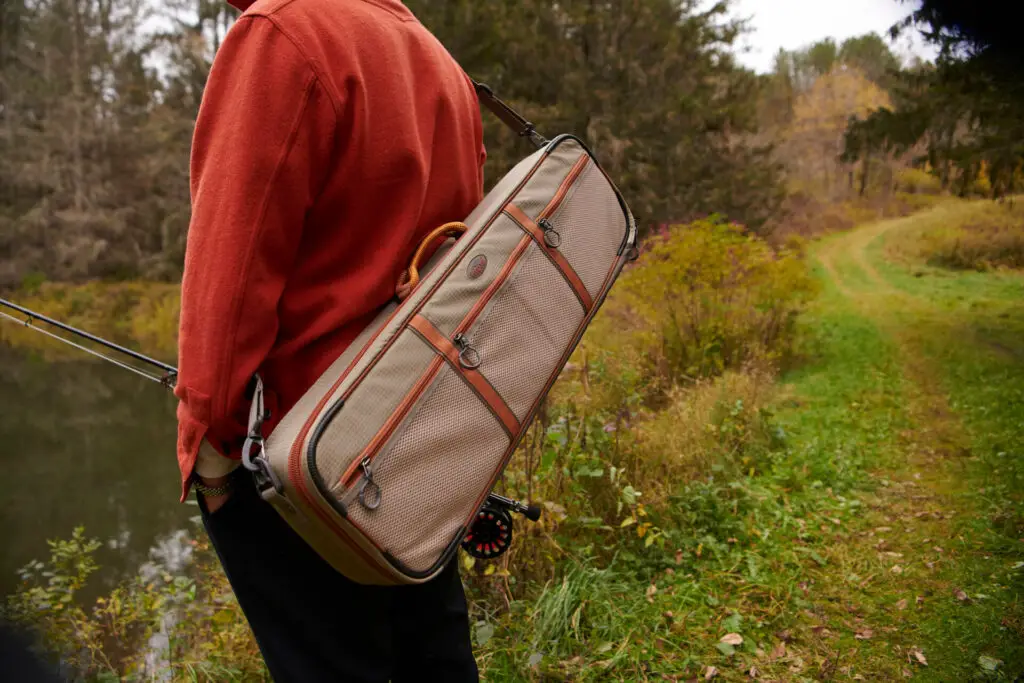
The primary goal of having a fly rod case is to make your traveling experience more convenient, so the portability feature must be greatly considered when purchasing one. The weight and shape significantly affect how portable a case is. Choose something lightweight if you travel frequently. Other than that, the shape of the case you choose should be comfortable to carry and can fit easily in a car trunk or overhead compartment on an airplane.
Straps help to secure the fly rod case during transport, preventing it from getting moved around and potentially getting damaged. Some fly rod cases come with simple webbing straps, while others come with padded or backpack-style straps that provide more comfort and support during transport.
When choosing a case, ensure that the straps are sturdy and reliable enough to secure the equipment in place when you’re on the move. You may also consider having adjustable straps so you can customize the fit of the case, essentially making it more comfortable to carry around.
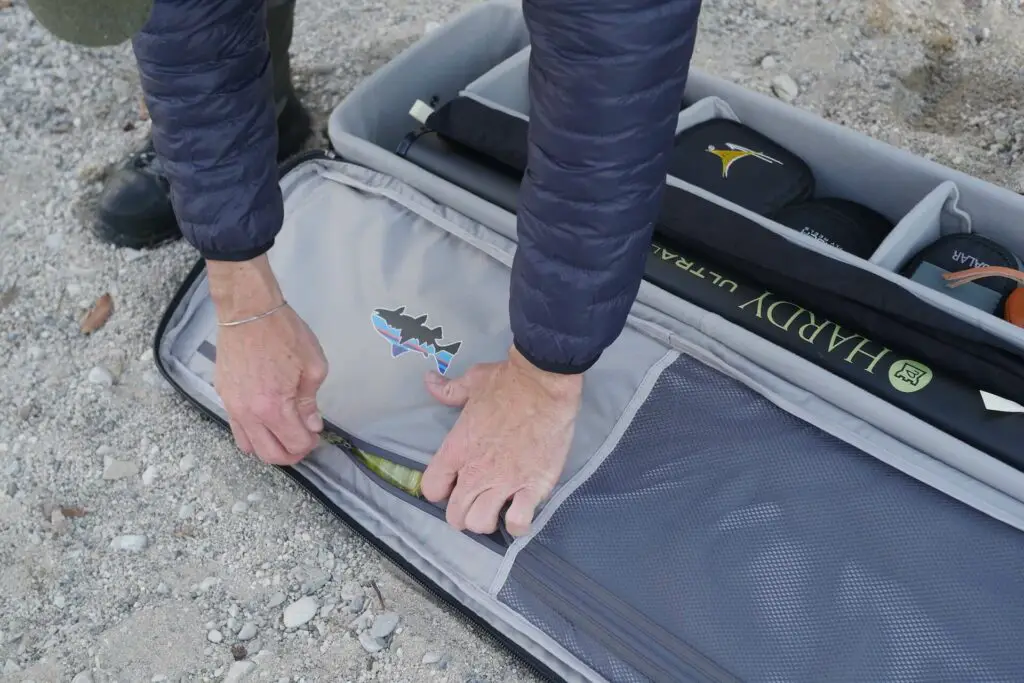
Dividers provide a protective barrier between each rod, preventing them from rubbing against each other during transport. This can cause damage to the guides, ferrules, and even the rod’s blank, leading to decreased performance and potentially costly repairs. They are often made of foam, plastic, or fabric.
Some fly rod cases even come with adjustable dividers, allowing anglers to customize the space to fit their specific fly rods. Simply put, dividers provide protection, organization, and customization, ensuring your fly rods stay safe and perform at their best for many fishing trips.
Versatility
There are fly rod cases that can be used as a backpack or a shoulder bag, which allows anglers to be hands-free—a good feat for navigating through different terrain types, such as hiking trails, beaches, or rocky riverbanks. A versatile fly case will provide you with flexibility and convenience, allowing fly rod transportation with ease.
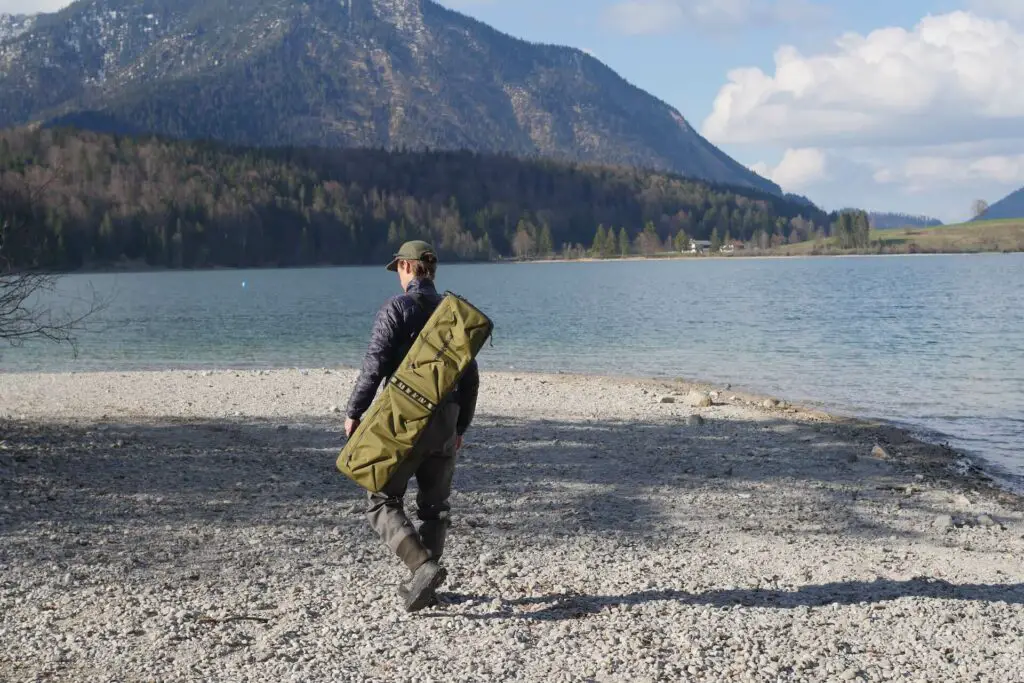
Some might think that a fly rod case is not a worthy investment because you can just make use of PVC pipes or electrical tubing for transportation, but in the long run, it would be easy to realize how it’s something truly essential for all your angling experiences. Fishing equipment is already expensive, so it’s easy to understand why one might shy away from buying even more costly add-ons, but a fly fishing rod case provides more than just comfort and aesthetics—it will ensure the longevity of your equipment so one way or another, it’s all worth the money spent.
Our Expertise
Leonard Schoenberger and his team spend plenty of days out fishing. Their goal is to test and review products for you so you can make a solid purchase decision and improve your fly fishing game. We always express our honest opinions, never get paid for reviews and are proud of our editorial independence.
FAQs: Best Fly Rod Case
What size fly rod case do I need for my fly rod?
The size of the fly rod case you need depends on the length of your fly rod. Measure your rod from tip to butt, including the reel, and select a case that is at least a few inches longer than your rod to provide a comfortable fit.
How many fly rods can a multi-rod case hold?
Multi-rod cases typically come in various capacities, ranging from 2 to 6 or more rods. The specific number of rods a case can hold depends on its design and size. Check the product description to determine the capacity of a particular case.
Are fly rod cases compatible with different rod types, such as single-handed or two-handed rods?
Many fly rod cases are designed to accommodate both single-handed and two-handed fly rods. However, it’s essential to check the product specifications to ensure compatibility with your specific rod type.
Can I carry other accessories, such as fly reels and fly lines, in my fly rod case?
Some fly rod cases have additional compartments or pockets for accessories like reels, fly lines, leaders, and tippets. These cases offer a convenient all-in-one solution for transporting your fly fishing gear.
Do fly rod cases meet airline carry-on size restrictions?
Some fly rod cases are designed to meet airline carry-on size restrictions, making them suitable for air travel without the need for checking in your gear. Check the case’s dimensions and airline regulations before your trip to ensure compliance.
Are fly rod cases water-resistant or waterproof?
Fly rod cases typically provide varying degrees of water resistance. While most cases protect against rain and splashes, not all are fully waterproof. If you plan to be in wet conditions or near water, consider a case explicitly designed for waterproofing.
Can I lock my fly rod case for added security during travel?
Many fly rod cases come with lockable zippers or built-in locks to provide added security during travel. If security is a concern, choose a case with these features to help protect your valuable fly fishing equipment.
Recommended Articles
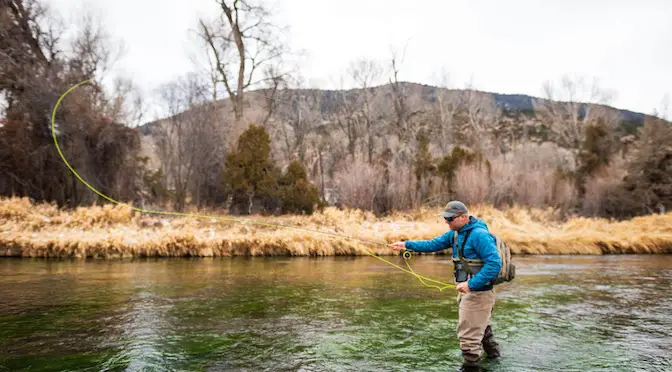
In today's fast-paced world, finding effective ways to manage stress and support mental health is more important than ever.
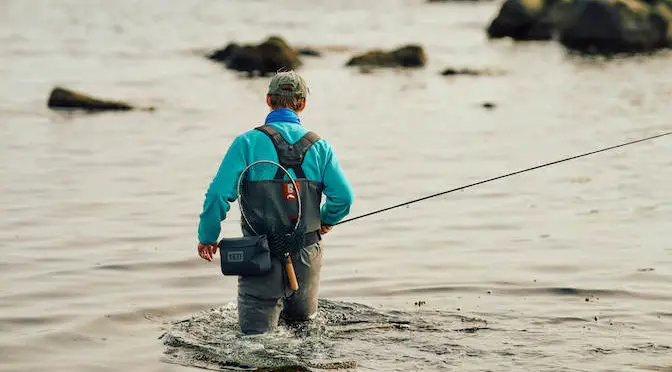
If you're heading out for a day of fly fishing, a waterproof bag can come in handy.
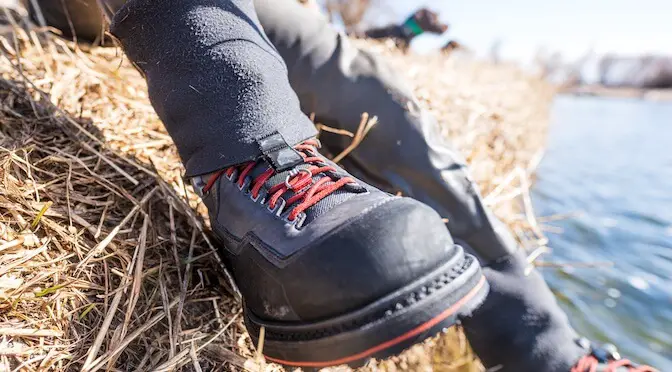
A year after the G4, Simms has reworked their mid-range wading boot G3. How good is it?
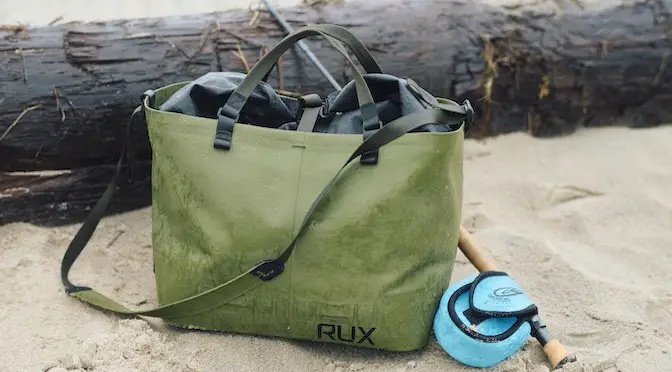
If you're heading out to fish in wet conditions, a waterproof bag will make your life easier.
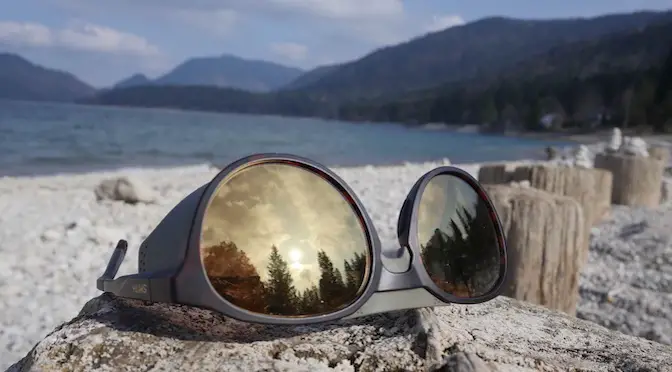
Doensn't it often feel like fly fishermen looked way cooler back in the days?
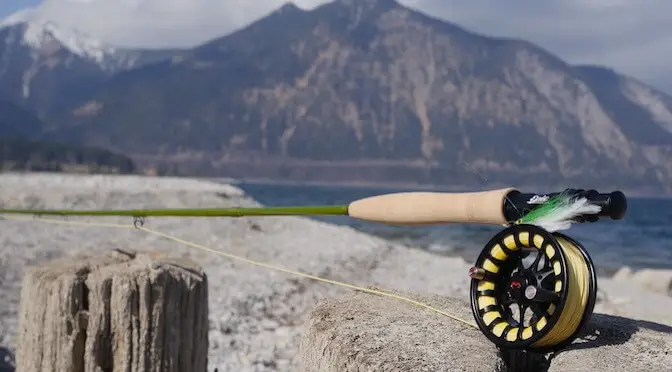
Most fly rod combos are made from carbon fiber. If you want something off the beaten path, take a look at the Epic Reference Packlight.
Fly Fishing Culture and Philosophy
The Global FlyFisher
Simply the best place to go for online fly fishing and fly tying.

Search form
Mobile menu.
- All content
- Your profile
- Pattern section
- Pattern list
- Today's Fly
- Your fly today?
- Streamers 365
- Tying cribs
- Review section
- Book reviews
- Video reviews
- Review policy
- Short takes
- Fishing section
- Rod building
- Destinations
- Fishing videos
- Tip of the day
- A better life
- Fly fishing
- Rod Building
- New comments
- Most commented
- More discussions
- Gallery section
- Photographers
- User's Pix
- Video section
- Fly tying videos
- Originators
- Suggest your own
- Video articles
- Stream fishing
- More keywords
- Staff section
- Submit pattern
- Copyright policy
- Author list
- Author bios
- About section
- Your account
- GFF on Facebook
- GFF on Pinterest
- GFF on Instagram
- GFF on Twitter
- No guest posts
- Not buying flies
- Support GFF
DIY Rod Tubes
You have one extra rod with no sock and rod tube. you've been putting off buying a tube...why don't you just make your own with $4.00 and about a 1/2 hour's time, you'll have a diy rod tube. these won't win beauty contests, but they work just as well as any retail version. read here how to diy..
They're not pretty, but they sure do work!
From time-to-time, somewhere down the line, you'll need a rod tube because of that one rogue rod without a sock and without a tube. But you've stalled on buying a rod tube becuase they are so darned expensive. The solution is to make your own! In under a half hour, you can fabricate a dozen or so tubes if you need that many. It's that easy! And the price is right too.
The materials
The materials required are minimal and the investment is small. You'll need:
- A china marker
- A fine-toothed, small kerfed pipe or hand saw
- PVC Primer and Cement
- PVC piping, schedule 40 works fine
- 1 closed endcap
- 1 open female-threaded endcap
- 1 male-threaded end plug
A simple cost breakdown reveals an appealing price to this Do-It-Yourself project. For a 3-foot rod tube, my costs were:
- PVC pipe: $0.238 per foot: $0.71
- 3'x1' flannel cloth for rod sock: $0.25
- Closed end cap: $1.49
- Threaded end cap: $0.98
- Threaded end plug: $0.57
- glue and tools: negligable cost
TOTAL COST FOR A 3-FOOT TUBE and sock cloth: $4.00

Getting started
Lay the PVC on a flat surface and measure your rod(s) against the PVC. Mark the cut point with a china marker. You can cut the PVC to the exact length of the rod as the end cap and threaded cap add about a 1/2" to the length, giving you an extra inch to play with. After the PVC sections are cut to length, line them up and arrange all the required end pieces behind the tube in the order in which you will assemble: closed end cap, then the threaded end cap. You'll be glad you organized the parts because PVC cement dries very quickly, leaving you little time to shuffle around looking for the parts.

Priming and cementing
Prior to assembling the parts, wipe them with a damp cloth to remove dust and shipping debris. This will aide in the priming and glueing steps. Also, be considerate of yourself and perform this step in a well ventilated area such as the back patio or your garage. All PVC needs some priming to 'scuff' up the surface. This is done with a chemical PVC primer. Be careful as PVC primer will most assuredly drip where you don't want it...it stains and it is sticky. Pre-fit the pieces to get a feel where the PVC contact points are. Then prime just those areas on each PVC tube. BE sure to prime the tube and the inside of each fitting. Apply the cement in the same fashion, coating both the PVC tube and the inside of the fitting with ample cement. Quickly assemble the fitting on the PVC tube and twist to ensure full coverage of the cement to all the glued surfaces. In just a few moments, the cement will set.

Once the tubes are assembled and glued, allow them an hour or so of curing time in a well ventilated area. It's not advisable to stick your rod in the newly glued tube...there just may be some cement that hasn't dried thoroughly.

The finishing touches
Although the picture to the right doesn't clearly show the markings, use a metallic permanent pen to label your rod tube with the contents. Rod socks can be purchased from most any rod making supplier for around $5 to $10, depending on the material you choose. Or, to carry the theme of this article, make your own rod sock to your exact specifications. Me personally, I like just a sheet of flannel the length of my rod and the width of a foot or so. I begin rolling in each rod segment in one at a time, like a wrapping a cigar. No stitching is required and the cost of the flannel is minimal at best. Then, insert the rod-in-sock, tighten the cap and go to the stream in confidence that your rod is safely protected! I actually needed a few rod tubes to mail some rods I had sold. After trying to find appropriate cardboard tubes of varying lengths, I decided to cost out making my own. In the end analysis, the cardboard tubes cost the same and in some cases more expensive for longer sections I needed. I then decided to make my own. These DIY rod tubes aren't going to win any beauty or crafstmanship awards, but with just a sheet of flannel and some PVC they are just as functional as any on the market...at 1/10th the price.

A gun sock that ties
A gun sock that ties works well to hold a couple of tubes for travel
Thanks. I've been t
Thanks. I've been thinking about this for a long time, but didn't think I'd be able to do it, and really didn't know how to go about it. :)
Hi Rudi These are a
Hi Rudi These are available here at Home Depot stores. The three I made three years ago I'm still using. If you're still in the market let me know how many you want and I'll make arrangements.
Hi I live in Isra
I live in Israel, I doubt I can find the:
- closed endcap - open female-threaded endcap - male-threaded end plug
Is someone willing to ship to me a few peaces? I will pay all expenses + a nice fee for your time.
Just reply here or pm if that is possible.

Sandy, I don't kn
I don't know whether they would be the best, but they would be fairly inexpensive, certainly better than no tube and you could make them exactly the length and diameter you wanted. Depending on the thickness material you choose for your tubes they could become a very good protection for your rods. Check out the options in your local plumbing supplies store. Plastic pipes for sink drains seem to be available in the proper diameters. They usually come in many lengths and can be fitted with plugs and end caps.
Hi, have a question
Hi, have a question about the rod tubes. I have some expensive rods and was wanting to make some rod tubes for them. They are 1 piece rods, 5'4 up to 7'10 and they are spinning rods. I'll probably have to have 2 1/2 in. pipe. I was wondering if these rod tubes would be the best for my rods and any ideas or suggestions. Thanks alot.
I was thinking of bu
I was thinking of building some rod case's and you gave me the boost I needed
I have made these fo
I have made these for a while as well. One touch that I add is after I get the pieces assembled, I will lightly sand the parts, and clean them well. Then I will spray the tube with a can of spray-on bedliner bought from AdvanceAuto. I will do a few coats, and increase my distance from the tube on the 2nd or 3rd coat to add more texture. It creates a very tough finish and has lasted me quite a while.
If you'd like a more
If you'd like a more attractive or unique case, there are two things I've done that others may find fun to try. Both options increase the cost slightly. First, you can purchase cordura fabric, factory seconds or closeouts, for ~$6.50 a yard (check ebay for example). Your case will look professional if you do this. This is exactly how the good cases are made. Simply glue the cordura to your pipe, or stitch a tube and slide the pipe in. You can even add webbing for a handle or sling.
Second, and the most fun IMO, is to purchase white pvc, not abs. Using a medium grain sandpaper, sand the length of tube. Get the entire surface sanded. Then, using a rough grain sandpaper (medium will also work) run the sand paper from top to bottom (once or twice only - do not sand back and forth for this step). Force the grit to slice vertical lines down the pipe. Different techniques will give you different effects, you'll have to experiment. Now for the trick - take your favorite color of wood stain, and stain the pipe. Run your clothsponge with the stain from the top of the tube to the bottom. You will notice immediately that your case is taking on an uncanny wood appearance. Some folks can't tell it's pvc even when holding the case. Using a small camp stove and leather gloves, you can kinkbendwarptwist the pipe to increase the wood effect before you sand and stain. Beware of fumes.
I've been making didgeridoo instruments this way for over a decade. Each one is unique, and I've never had anyone guess it was pvc.
Tracy, They can b
They can be checked in, and will do nicely and be sturdy enough for air travel. But don't expect to bring them as hand luggage - or anything like them. Those days are over. Security is much too tight to let anything like a rod tube go through these days.
Can these types of r
Can these types of rod cases be taken on airlines?
I just used ordinary
I just used ordinary contact cement to attach the PVC fittings. Buying the actual primer and cement would have added another $5-6.00 dollars to the two tubes I built. I was able to get the contact cement at a local dollar store. It's been two years and no problems.
Hi Steven Great ide
Hi Steven Great idea. Thank you! Did you use 1 1/2" or 2" PVC?
Pvc is wonderful stu
Pvc is wonderful stuff, man. The (dubmon1)
You guys are always
You guys are always thinkin, man. Your fly patterns are some of the very best I have ever tied/used. when I need some help with anything to do with or about fly fishing, I come here. Thank you very much people. the (dubmon)
I had two rods that
I had two rods that had their gloss finish bubble completely off from storing a rod in a PVC rod tube that was homemade. I was able to scotchbrite the failed finish off, and refinish the rods. Since then, I know there have been changes made in PVC formulations, so I don't know if this may happen with some rods or not. Also, I can't speak for black ABS, but I thought it was worth mentioning.
I've made several of
I've made several of these over the years, the last for a 2 piece 9 1/2 foot 8 wt that was going in baggage when I flew back east. I went with an end cap I found in the hardware store that screws in flush with the end of the tube. It has an indented cross, like a huge phillips head screw, that requires a tool to open. I felt this would dicourage the merely curious from getting into it in transit. I also like to add a handle and shoulder strap that I pop rivet in place-but ALWAYS use a rod sock as the end of the rivet on the inside of the tube can scratch the rod.
What store do you bu
What store do you buy your PVC tubing from? I went to a local LOWE'S and HOME DEPOT but they only carried the thick walled super heavy big tubes? I like in Detroit, MI. Any suggestion would be nice ASAP. Thanks!
Another great produc
Another great product for making rod tubes is central vac tubing available at any large building supply outlet like Home Depot etc. There are even snug fitting end caps available to seal up the ends. What I do is cut the pipe to length, wet sand it with about 600 or 800 grit to make it shiny and slick. Glue the end cap in place for the bottom (put some closed cell foam in the bottom of the cap for rod protection) I then drill a small hole in the top cap (perfectly centered) and another in the side of the tube. These are done to connect the top cap to the tube with a piece of small diameter rope. Central vac tubing is made up of the same material as the PVC mentioned above (at least I think it is) but it has thinner side walls. It's still very durable however. I have found it in white and grey colors. It's pretty cheap as well. A 12ft length cost me about $10.00 and the matching end caps were $0.50 a piece.
If I'm not mistaken,
If I'm not mistaken, that's ABS pipe, which is chemically different from PVC, and has its own specific primer.
Using PVC cement will help make a mechanical joint between two pieces of ABS, but if you want a permanent joint (one that won't come apart when subject to baggage handling abuse), you may want to use the primer and cement that's specifically made for ABS.
The pictures indicat
The pictures indicate tubes of ABS not PVC. Is this correct?
I made one of these rod Tubes For my Three Piece Fly Rod.
I made one of these rod Tubes For my Three Piece Fly Rod.I'm not paying a big price for a ROD TUBE? when there so easy to make
Add new comment
Related content, more content from the front page.

Chain Gang Crayfish

Intruder conversions
I got the crazy idea to convert some Danish sea trout and salmon flies to intruders. It worked out surprisingly well.

Since you got this far …

… I have a small favor to ask.
Long story short
Support the Global FlyFisher through several different channels, including PayPal.
Long story longer
The Global FlyFisher has been online since the mid-90's and has been free to access for everybody since day one – and will stay free for as long as I run it. But that doesn't mean that it's free to run. It costs money to drive a large site like this.
See more details about what you can do to help in this blog post.


Moscow Muled
Why do moscow mules come in copper mugs.
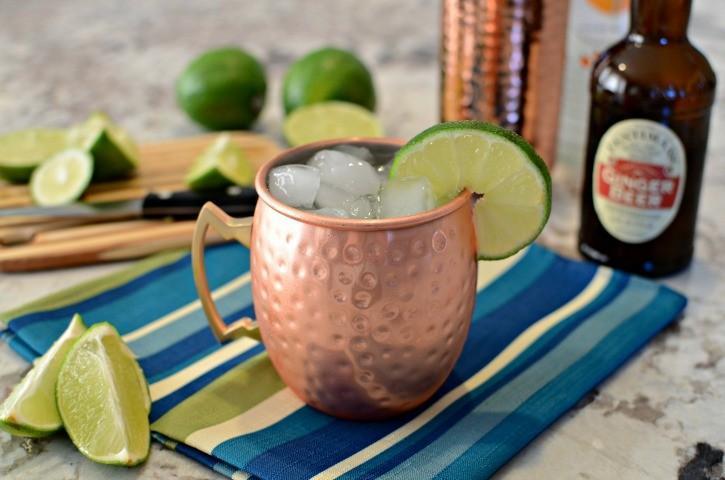
Oct 18, 2019
Have you ever wondered why the Moscow Mule cocktail is served in a copper mug? In this post, we answer that question in detail. As it turns out, the answer is partly based on historical events and partly based on the extra "kick" that copper brings to this classic cocktail. Let's dive in!
Introduction

A remarkable cocktail is something you notice from across the room, easily identified by the signature drinking vessel it's served in. Few are more distinct than the burnished copper mug of a Moscow Mule.
Great cocktails aren't just alcohol and mixers––they should be something more, a full sensory experience from beginning to end. It starts as you observe the precise convergence of ingredients in a golden ratio that blossoms into flavors and aromas of citrus and spicy ginger. It is then delivered into an ice-filled copper mug and garnished with fresh mint and a slice of lime. Finally, it is presented before you, shiny and cold, compelling you to taste.
The copper mule mug not only tells the story of the drink it contains, but also is essentially functional to the full experience. You might already know that the cone-shaped bowl of a long-stemmed Martini glass was designed so that olives would stand perfectly upright, and the elegantly curvaceous welled Margarita glass was designed to add ample salt, sugar and garnishes.
But why are Moscow Mules served in copper mugs?
Inquiring minds want to know, so this article will sum up the science and history of why traditional Moscow Mules come in copper mugs, and other legit benefits of serving cocktails in pure copper mugs. This includes:
A Brief History of the Moscow Mule
The science of using copper mugs.
- How Copper Mugs Amplify the Taste & Aroma of your Moscow Mule
- The Enhanced Experience of Drinking from a Pure Copper Mug
The origin of this timeless cocktail is the tale of the American Dream. One fateful day in 1941 , three struggling entrepreneurs had a serendipitous meeting at the Cock 'N Bull bar on the Sunset Strip in Hollywood: A bar owner passionate about his unpopular home-brewed ginger beer, a businessman who took a big chance and purchased Smirnoff vodka, and a Russian immigrant with a cache of copper mugs she couldn't seem to sell. That day, the unlikely trio wisely decided to join forces in a bold venture that would not only save their individual businesses, but also create an iconic American cocktail.
Essentially, the Moscow Mule is the most successful marketing campaign in cocktail history. At a time when most Americans had never even heard of vodka, this cocktail introduced them to the traditional Russian alcohol, and established Smirnoff as a necessity in both bars and homes alike.
Thanks to celebrity endorsement, the Moscow Mule soon took the Hollywood cocktail scene by storm, and quickly became the most beloved mixed drink of the 1950's.
It's popularity understandably waned during the Cold War, and it was briefly re-branded as the Smirnoff Mule to distance itself from communism. However, the recent cocktail renaissance of the 21st century has seen the Moscow Mule come kicking back, as evidenced by lists like Esquire's Top 10 Cocktails of 2019 , and Business Insider's 8th Best-selling Cocktail in the World, 2018 .
But the answer to why Moscow Mules are served in copper mugs goes much further than a conveniently clever alliance between co-founders desperate for a big break. The story of the Moscow Mule is both the struggle of the immigrant searching for success, and the flashy lifestyle of the rich and famous.
It boasts a simple recipe , yet a complex flavor profile, encapsulated in a shiny copper mug. And as delicious and refreshing as the Moscow Mule may be, it's the copper mug that makes the cocktail so extraordinary. Like the drink itself, the pure copper mule mug is a balance of form and functionality.

The most scientific benefit of the copper mug is its ability to regulate temperature. When a drink is served in a copper mug, it gets cold fast––and stays that way.
Copper is a renowned thermal conductor that will keep your beverage frosty in any weather, and is one of the reasons the traditional Moscow Mule has become synonymous with summer. Add a little ice, and the copper chills drinks instantly, and sustains a refreshingly icy rim with every sip.
Because copper is such an excellent conductor, it can keep your cold beverages colder for longer. The downfall of many ill-fated cocktails on a hot summer day is melting ice. Copper mugs stay brisk, and don't disrupt the recipe's ratio, so the simple yet distinct flavors of the Moscow Mule remain strong till the last drop.
Another important feature of the solid copper Moscow Mule mug is the handle. Much like the stem of a wine glass, the copper mug handle keeps the nearly 100 degree body temperature of your hand from impacting the status of your deliciously frosty cocktail.
How Copper Mugs Amplify the Taste and Aroma of Your Moscow Mule
If you want to know what a Moscow Mule tastes like, purists would insist the only way to experience it is in a 100% copper mug. Aside from being a great American tradition, copper mugs offer some unique enhancements to both the flavor and aroma of the Moscow Mule (or almost any finely-crafted cocktail).
Although subjective, most discerning drinkers would agree that copper mugs imbue cocktails with a superior taste. Experts explain that the copper oxidizes the vodka upon contact, thus enhancing the flavor profile and potency of the aromatics.
The intense cold of the copper also creates more stability in the bubbles of the ginger beer carbonation, and balances the tangy citrus of the lime with the earthy spice of the ginger.
For the skeptics out there, the theory of superior taste is easily verifiable. Simply make or order two Moscow Mules––one served in a plastic cup, and one served in a copper mug. Take a moment to inhale deeply, enjoy a big sip, and let your senses be the judge.
The epiphany should take a matter of moments, and you soon realize why a Moscow Mule is best served in a copper mug, and why any other cup or glass is vastly inferior. The difference can be so vivid, you might even consider drinking all your favorite beverages from copper mugs, even hot tea and coffee!
The Enhanced Experience of Drinking From a Pure Copper Mug
Throwing back shots with reckless disregard is a great way to get hammered, but a terrible way to enjoy something delicious. People order cocktails for the full package––observing its creation, revelling in its presentation, and slowly savoring its captivating story and unique taste.
Not only is a cocktail a well-balanced combination of spirits and mixers, it's also about the aesthetic and function of the vessel it's served in. A cocktail should be an object of inspired beauty, presented thoughtfully in a suitable glass or mug and garnished appropriately. It should take time, because it's made by hand.
Although the copper mug has become the symbol of Moscow Mules, it can also pair exquisitely with many other cocktails. Many people seem drawn to the shine and nostalgia of the metal, and Mixologists seem impressed by the scientific properties of the copper mug. Other drinks prominently featured in copper mugs include Dark 'n Stormy, Mescal, Gin & Tonic, and Cuba Libre.
No matter how frosted a beer glass gets, nothing can keep a mixed drink colder than a copper mug. The sensation when one's lips touch the ice-cold rim with every sip is part of the unique experience.
The flavors are heightened, the aromas amplified, and the balance of vodka, lime juice and ginger beer is never watered-down by melting ice. Provided your Moscow Mule is served in a pure copper mug, the last sip should be just as robust and enjoyable as the first.
The benefits of drinking from copper mugs aren't a newfound discovery. In fact, copper has been the preferred metal for drinking vessels for thousands of years.
Gurus in India have been using copper mugs for hundreds of years, and copper goblets called Escra have been found in ancient Irish ruins. Even American settles in 1645 drank exclusively from a massive tankard made of pure copper, known today as the Virginia Tankard .
The Moscow Mule is a classic drink served in a magnificent copper mug because it tells a compelling story, and enhances your consumption experience. It is an unforgettable drink because it's served in a mug that is both more beautiful than and functionally superior to glass.
Three Reasons Moscow Mules Come in Copper Mugs
The reason your Moscow Mule is served in a copper mug is not a fluke. It is not because it's the latest trendy hipster craze. It's not just a marketing ploy (although it definitely started out as one), nor is it a conspiracy by the lobbyists for Big Copper.
Moscow Mules come in copper mugs for three reasons: taste, temperature, and presentation.
The unique experience of drinking a Moscow Mule is a balanced combination of these three elements. It's also the reason this drink is not only the most recognizable, but also consistently one of the most popular drinks in global cocktail culture history.
Taste: The natural properties of the copper oxidize the alcohol, resulting in powerful aromatics and superior flavors. The bubbles of the ginger beer stay fizzy, and perfectly counter the acidity of the fresh lime juice. It's spicy yet refreshing. Simply put, it's delicious!
Temperature: Copper is an ideal thermal conductor, instantly chilling your beverage upon creation, and maintaining a consistently arctic temperature. This prevents the ice from quickly melting and dulling the cocktail ratio, while keeping the rim refreshingly frosty with every sip. The handle also keeps your hot little fingers from fluctuating the temperature with every touch.
Presentation: A glinting copper mug looks authentic and catches the eye. It is vintage, yet modern, and tells a story of creativity, charm and resilience. It is instantly recognizable, and makes for a fine looking beverage. Yes please!
The Bottom Line
The copper mug is iconic, a great American tradition of nearly 80 years, and is the only proper way to drink a Moscow Mule. Cheers!
Did You Enjoy This Article?
Thank you for reading! If you enjoyed this article, you might also like the following articles: How to Clean and Care for Copper Mugs: The Definitive Guide and Why You Should Only Use Moscow Mule Copper Mugs With Stainless Steel Lining
Relevant Products
Moscow Mule Copper Mug
Leave a comment
Subscribe to our newsletter.
Receive exclusive deals and our latest blog posts straight to your inbox!
- Tour Account ›
- Travel Forum ›
- Travel Forum
A trip to Moscow
I'm going to organize a trip this summer. I want to plan everything. I’ll fly from London to Moscow, and I also want to visit St. Petersburg. Could you, please, advise me what places I should visit? I’ll stay in Moscow for about 10 days before going to St. Petersburg. Thank you!
Not a country I’d be spending my money in at the moment.
Ditto. Ditto!
I don't really see the point of shunning a country because you don't agree with its leader and/or its government. Would you go to Italy? China? Tourist dollars are more likely to get into the hands of the people rather than any corrupt bureaucracy and meeting friendly tourists might just change the locals opinions of foreigners and even give them some information they don't get from local news media.
Hopefully , I won't be starting a war here , but I must say I agree with Chani's comments . Having taken three year visas in 2015 , we have been to Moscow and St; Petersburg ( once to Moscow , and twice to St Petersburg ) . The History , Art , Music ( I am a classically trained musician ) and Culture , fascinate us . Much to experience there and advance preparation is essential , To get a good grounding for your visit , read this lavish and detailed book by Suzanne Massie , it's one of the best ways to immerse yourself in what you will experience - https://www.amazon.com/Land-Firebird-Beauty-Old-Russia/dp/096441841X/ref=sr_1_1?ie=UTF8&qid=1521652009&sr=8-1&keywords=land+of+the+firebird+massie&dpID=51CPK13XKGL&preST=_SX218_BO1,204,203,200_QL40_&dpSrc=srch
And while leaders of such countries can point to foreign visitor numbers as a sign of support ? I also believe that personal safety for certain travellers, especially obvious minorities, cannot be guaranteed, as fervent nationalism increases, and tolerance levels evaporate. Just as I may decide against a purchase at the supermarket because of a company’s behaviour, ethics will always be a consideration.
Well, I'd argue supermarket ethics does not readily translate to travel ethics - the latter is far more complex. Personally, I see the whole "vote with my hard-earned travel dollar" approach as overly simplistic, but if it's your position - I totally respect it.
What I don't understand is members volunteering ethical guidance in response to what seems an innocuous request for travel-related information.
Note a discussion on ethics hosted a year ago by the Webmaster of this very forum.
https://community.ricksteves.com/travel-forum/general-europe/travel-ethics-612334a0-0ca1-4128-b088-c13d1d8a91c3
I appreciate Rick Steves' point of view in his "Travel As A Political Act". That said, Putin's Russia is not a place I would support. But, to each his or her own....
From a practical point of view, travel between the two countries can be difficult. I understand the Russians who traveled in the US this past winter had to go to the US Embassy in the country of Georgia to get visas because the Russians expelled American embassy personnel. If you do travel to Russia, you may be on your own. See the American travel advisory: https://travel.state.gov/content/travel/en/traveladvisories/traveladvisories/russia-travel-advisory.html
Travel Advisory January 10, 2018 Russia – Level 3: Reconsider travel Reconsider travel to Russia due to terrorism and harassment. Some areas have increased risk. Read the entire Travel Advisory U.S. citizens are often victims of harassment, mistreatment, and extortion by law-enforcement and other officials. U.S. consular assistance to detained individuals is often unreasonably delayed by Russian officials. Russia also enforces special restrictions on dual U.S.-Russian nationals. Due to the Russian government-imposed reduction on U.S. diplomatic personnel in Russia, the U.S. government has reduced ability to provide services to U.S. citizens.
We have traveled to Moscow and St. Petersburg over the past few years. As in the US, most of the people we encountered helpful and not particularly political. In Moscow, we stayed at The Garden Ring Hotel which was a close walk to the metro. The hotel was very comfortable and quiet for being in the city. We loved the art museums and the Georgian restaurants. In St. Petersburg, we stayed at both The 3Mosta hotel near the Hermitage and the Art Hotel Demetra.. In St. Petersburg, we especially liked the Hermitage and Russian museum. Learning the Cyrillic alphabet and having a good map is a must.
As I think the point about ethical considerations has been made, please keep future replies more specific to the question at hand. Thanks.
Either read a good travel book or book a guide who can personally take you to the best places that interest you and tell about the sights you're seeing. We used Dan Petrov on 2 different trips to Moscow and found him to be wonderfully friendly and witty not to mention super knowledgeable.
Latest advice, Australian Governmemt, 1 April 2018. “Due to heightened political tensions, you should be aware of the possibility of anti-Western sentiment or harassment. While the Australian Government is not aware of any increased difficulties for Australians travelling in Russia at this time, you should follow the security and political situation closely and keep up to date with this travel advice. Remain vigilant, avoid any protests or demonstrations and avoid commenting publicly on political developments.”
We very much enjoyed our group trip to Moscow and St Petersburg last year. excellent guides and accommodations. While Steven who has replied here has excellent advice, ( and we took advantage of it), we felt an organized tour really facilitated our enjoyment of the country. You may want to consider a combination of an organized tour and than adding independent days . Some of the Australians on the tour had arrived a couple of days earlier than the tour stated and then some stayed later. If we were to go again (which I would), that"s how I would do it. And I must say , it was enlightening to have conversations with the Russian tour guides and the non Americans about the current world situation. Not that we went into any great depth, but I think we all went away with a little more understanding. Top places: allow lots of time in St Petersburg at the Hermitage- take a separate day for the Impressionist building. In Moscow, the Russian Art Museum was amazing.
Solid advice from Australian government quoted above, especially the keeping up to date part.
I checked the current version (Sep 18) of that advisory - and it hasn't been updated much. In fact, some sections don't seem to have changed since 2005 - their recommendations for importing/exporting currency and financial instruments, for example, are at least five years behind.
I do like reading governmental travel advisories for entertainment purposes - for instance, up until very recently the US one sternly advised potential travelers that Moscow was largely a cash-based economy (couldn't be further from the truth) and warned about intrinsic dangers of gypsy cabs (which had all but disappeared by 2015).
This topic has been automatically closed due to a period of inactivity.

IMAGES
VIDEO
COMMENTS
In this video we build our own fishing rod travel case out of PVC. If you are looking for a DIY travel tube for your fishing rods, check out the video!We lov...
Step 1: Measuring and Cutting the PVC Pipe. Measure the length of your longest fishing rod and add a few extra inches to ensure enough space for padding at both ends. Use the saw to cut the PVC pipe to the desired length. Smooth the cut edges with sandpaper to prevent sharp edges from damaging your rods.
The way I transport my rods I just needed a way to protect the rods. This is fairly simple and you can make it your own. Materials:2" vacuum PVC and an end c...
Step 1: Cut the Tube to Length. Using your maximum length rod as a point of reference, cut the tube 3" longer than your longest rod. In my case the longest rod is 7'6" so I cut the tube to 7'8". Begin by laying out the 1" square tube as seen in the picture above and welding the frame together. The heavier 11ga square tube will help ...
When choosing a fishing rod travel case, there are 13 key aspects to consider: Material: Hard plastic or aluminum provides the best protection. Size: Should accommodate all of your rods and reels. Compartments: Multiple compartments keep rods and reels organized. Padding: Protects rods from damage.
I show you how to make a cheap and durable fishing rod case using PVC pipe. This is a very easy DIY project and inexpensive way to protect your fishing rods....
Plano Airliner Telescoping Rod Case - Amazon. $65.99. This fishing rod tube is basically the iFly luggage of fishing pole cases. The case extends to 88 inches and collapses to 47 inches in length for easy storage. It can carry up to eight 7-foot rods. The three-tier design is truly top-tier.
But travel is hard on fishing gear, especially fishing rods. We have been experimenting with different options for traveling with our fishing rods and decided to make a travel case for our 2 piece ultralight rods. Check out the video by clicking the image above to see how to build your own fishing rod travel case!
A fishing rod travel case 7ft is a protective case designed to store and transport fishing rods up to 7 feet in length. It is typically made from durable materials like nylon or hard plastic to safeguard the rod from damage during travel. These cases often feature multiple compartments, adjustable straps, and padding for added protection.
This innovative and versatile case has become my go-to for all my fishing trips, and I'm excited to share its benefits with you. So sit back, relax, and let me take you on a journey through the world of portable fishing gear. I Tested The Fishing Rod Travel Case 8Ft Myself And Provided Honest Recommendations Below
Travel Fishing Rod - Make It Yourself: I wanted a travel size fishing rod to carry in a saddle bag or back pack. Because no matter which way I go to work I ride right past at least one boat ramp with a fishing pier. Then I got sticker shock when I checked out the prices.&nb…
This hard case rod tube measures up to 87 inches in length. Flambeau Tackle. Flambeau's contoured, blow-molded Bazuka rod tube is tough, built to stop the bends, crushes or breaks that destroy rods in a soft-sided bag. With a 3-inch diameter, and measuring anywhere from 63 to a telescoped 87 inches, the one-piece rod tube handles up to six 6 ...
3. Roof Vaults. Roof Vaults are great for anglers fishing out of their vehicles. Particularly, fly-fishing anglers and surf casters with exceedingly long rods. Jumping around from spot to spot on the river or lake to lake gets much easier with these roof vault type cases. For longer rods, roof vaults offer the quick and easy convenience/access ...
Next, use a clamp to attach the two pieces of PVC pipe together. Make sure that the clamps are tight, so that the PVC pipe does not move. Once the PVC pipe is clamped together, use a tape measure to measure the width of the fishing rods. Next, use a hacksaw to cut a piece of PVC pipe to the desired width.
This is my replacement rod travel case the old one just wore out after 15 yrs. I show how to assemble for every day use, when air travel I just secure the c...
Why we picked it: Made from tough 300-denier post-consumer recycled polyester fabric with a recycled TPU laminate, the Patagonia Black Hole® Rod Case (read our in-depth review here) is built to withstand years of travel and outdoor use.With an internal length of 36″ and the ability to fit four-piece rods up to 11′, this case offers plenty of space to store your valuable fishing equipment.
DIY Rod Tubes. They're not pretty, but they sure do work! From time-to-time, somewhere down the line, you'll need a rod tube because of that one rogue rod without a sock and without a tube. But you've stalled on buying a rod tube becuase they are so darned expensive. The solution is to make your own!
The reason your Moscow Mule is served in a copper mug is not a fluke. It is not because it's the latest trendy hipster craze. It's not just a marketing ploy (although it definitely started out as one), nor is it a conspiracy by the lobbyists for Big Copper. Moscow Mules come in copper mugs for three reasons: taste, temperature, and presentation.
If you are looking to go on a fishing trip but not sure how you will be able to pack your fishing rods in a safe manner, this video gives you an easy idea to...
From a practical point of view, travel between the two countries can be difficult. I understand the Russians who traveled in the US this past winter had to go to the US Embassy in the country of Georgia to get visas because the Russians expelled American embassy personnel. If you do travel to Russia, you may be on your own.
Steelhead are the cause of a lot of excitement in any area of the world which is fortunate enough to have them swimming in its rivers. These silvery sea-run rainbow
This Drink & Barware item by MontanaArtSpot has 114 favorites from Etsy shoppers. Ships from Lakeside, MT. Listed on Aug 29, 2023
How To Make EASIEST DIY FISHING ROD TUBE FOR LESS THAN TT$100.00 | TRAVEL CASE | NO TOOLS NEEDED#rodcase #diy #fishinghack Just a quick DO IT YOURSELF video ...